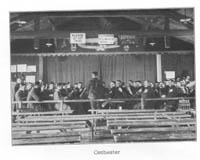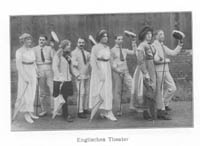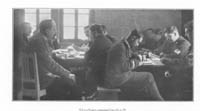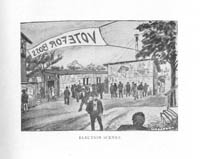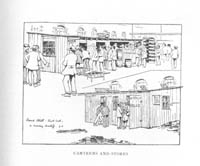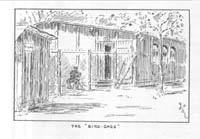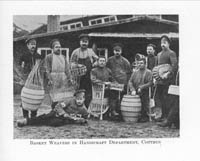Table of Contents
Chapter 6
"In Prison, Ye Visited Me": The American YMCA Secretaries Initiate POW Relief in Germany
1
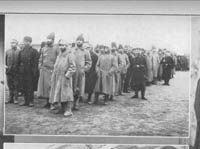 The American YMCA's decision to focus on relief services for war prisoners reflected many of the primary
objectives of the Association. The POW survived in a precarious situation. A burden to his captors but beyond
the assistance of his comrades, the POW became the "forgotten man" of the war. His captor's interests-whether
political, military, or social-did not promote prisoner welfare. Captor nations concentrated scarce national
resources into the war effort and the survival of their civilian populations, while the POW remained the
"enemy," a burden on the economy. This scenario was especially relevant for Allied prisoners languishing in
Central Power military prisons, since the Allied command imposed a blockade on Germany to deprive the empire
of needed raw materials. Therefore, prisoners, in their isolated position, were ideal candidates for the
ministrations of the YMCA. Red Triangle secretaries were motivated by the Biblical imperative to visit those
in prison: "In prison, Ye visited me…"1 The
Association leadership saw the Great War as a unique opportunity for the YMCA to meet a global need. As John
R. Mott pointed out in June 1916, the YMCA "under the current circumstances is having an opportunity under God
which will count more for the religious uplift of the world than any similar effort ever made."2 More importantly, the POW was a burden shared by all belligerents.
Assistance to war prisoners reflected the American YMCA's neutrality and bolstered the Wilson Administration's
foreign policy goal of dealing fairly and impartially with all of the nations at war.3
The American YMCA's decision to focus on relief services for war prisoners reflected many of the primary
objectives of the Association. The POW survived in a precarious situation. A burden to his captors but beyond
the assistance of his comrades, the POW became the "forgotten man" of the war. His captor's interests-whether
political, military, or social-did not promote prisoner welfare. Captor nations concentrated scarce national
resources into the war effort and the survival of their civilian populations, while the POW remained the
"enemy," a burden on the economy. This scenario was especially relevant for Allied prisoners languishing in
Central Power military prisons, since the Allied command imposed a blockade on Germany to deprive the empire
of needed raw materials. Therefore, prisoners, in their isolated position, were ideal candidates for the
ministrations of the YMCA. Red Triangle secretaries were motivated by the Biblical imperative to visit those
in prison: "In prison, Ye visited me…"1 The
Association leadership saw the Great War as a unique opportunity for the YMCA to meet a global need. As John
R. Mott pointed out in June 1916, the YMCA "under the current circumstances is having an opportunity under God
which will count more for the religious uplift of the world than any similar effort ever made."2 More importantly, the POW was a burden shared by all belligerents.
Assistance to war prisoners reflected the American YMCA's neutrality and bolstered the Wilson Administration's
foreign policy goal of dealing fairly and impartially with all of the nations at war.3
2
 The American YMCA adopted a three-level strategy in meeting the needs of Allied prisoners and, in the process,
fulfilling the Association's mandate: to combat "barbed-wire disease," the boredom associated with languishing
without purpose in prison; to make incarceration a rewarding experience; and to gain access to new areas of the
world for future missions. While the American YMCA had gained some limited experience in providing welfare work
to prisoners through secretaries that visited inmates in American penitentiaries before the war, this was a new
mission field. Despite this, the Association's four-fold program could be modified by secretaries to meet the
conditions in specific POW compounds.
The American YMCA adopted a three-level strategy in meeting the needs of Allied prisoners and, in the process,
fulfilling the Association's mandate: to combat "barbed-wire disease," the boredom associated with languishing
without purpose in prison; to make incarceration a rewarding experience; and to gain access to new areas of the
world for future missions. While the American YMCA had gained some limited experience in providing welfare work
to prisoners through secretaries that visited inmates in American penitentiaries before the war, this was a new
mission field. Despite this, the Association's four-fold program could be modified by secretaries to meet the
conditions in specific POW compounds.
3
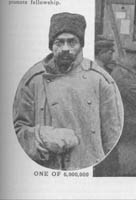 The primary objective was to provide welfare relief to "save" war prisoners from "barbed-wire disease."
This condition progressed as the prisoner languished in captivity. Its chief causes were insufficient diet,
poor sanitary conditions, and most importantly, the daily monotony of the prison routine. To combat this
condition, the American secretaries instituted the four-fold YMCA program, which stressed physical, mental,
social, and spiritual relief. Red Triangle workers reduced camp monotony by offering inmates diversions and
instilling a sense of hope that they would eventually be reunited with their families. Over time, as conditions
in Central European prisons deteriorated, this strategy evolved to simply looking after the survival of Allied
prisoners.4
The primary objective was to provide welfare relief to "save" war prisoners from "barbed-wire disease."
This condition progressed as the prisoner languished in captivity. Its chief causes were insufficient diet,
poor sanitary conditions, and most importantly, the daily monotony of the prison routine. To combat this
condition, the American secretaries instituted the four-fold YMCA program, which stressed physical, mental,
social, and spiritual relief. Red Triangle workers reduced camp monotony by offering inmates diversions and
instilling a sense of hope that they would eventually be reunited with their families. Over time, as conditions
in Central European prisons deteriorated, this strategy evolved to simply looking after the survival of Allied
prisoners.4
4
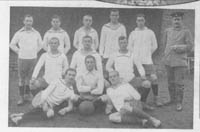 The first element of the Association program developed the prisoner's physical condition. Secretaries
encouraged POWs to stay in good shape through exercise and competitive sports. The YMCA improved sanitation
facilities (showers, baths, water purification, and delousing plants) and medical resources (dental and
disinfectant equipment, medical supplies, and infirmaries) to prevent the physical deterioration of prison
populations. Second, the Association's program emphasized sound mental health through projects designed to
break the camp's monotony.
The first element of the Association program developed the prisoner's physical condition. Secretaries
encouraged POWs to stay in good shape through exercise and competitive sports. The YMCA improved sanitation
facilities (showers, baths, water purification, and delousing plants) and medical resources (dental and
disinfectant equipment, medical supplies, and infirmaries) to prevent the physical deterioration of prison
populations. Second, the Association's program emphasized sound mental health through projects designed to
break the camp's monotony.
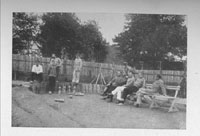 The secretaries set up a wide range of activities, including extensive libraries in numerous languages, arts and crafts materials, and schools that ranged from
remedial reading and arithmetic to university courses. The third element, closely aligned with the second,
was social development. The YMCA supplied musical instruments and sheet music to POWs to form orchestras, bands, and choirs, and the Association supported theatrical productions by sending scripts, costumes, and stages.
The secretaries set up a wide range of activities, including extensive libraries in numerous languages, arts and crafts materials, and schools that ranged from
remedial reading and arithmetic to university courses. The third element, closely aligned with the second,
was social development. The YMCA supplied musical instruments and sheet music to POWs to form orchestras, bands, and choirs, and the Association supported theatrical productions by sending scripts, costumes, and stages.
 The Association
also set up prisoner information bureaus to provide prisoners and their families with some measure of
emotional relief by locating prisoners and establishing contact. Prisoners were able to receive food
parcels or money, which became essential to supplement their meager diets.5
The Association
also set up prisoner information bureaus to provide prisoners and their families with some measure of
emotional relief by locating prisoners and establishing contact. Prisoners were able to receive food
parcels or money, which became essential to supplement their meager diets.5
5
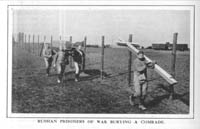 The final element of the POW program focused on the spiritual needs of the prisoners, by providing places
of worship and religious services. The Association tried to provide prisoners with clergymen of their own
faiths by transferring captured chaplains to camps with underserved spiritual needs. If captive chaplains
were unavailable, secretaries worked to persuade local clergy to visit prison camps and perform services.
The YMCA also provided such religious articles as vestments for ministers, special kosher foods, and blessed
altar cloths for Orthodox services. In addition, the Association made special efforts to make sure prisoners
had a merry Christmas, especially since POWs felt especially vulnerable separated from family and friends.
Secretaries decorated the huts, provided Christmas trees, and worked to make sure that even the poorest
prisoners received a small gift.6
The final element of the POW program focused on the spiritual needs of the prisoners, by providing places
of worship and religious services. The Association tried to provide prisoners with clergymen of their own
faiths by transferring captured chaplains to camps with underserved spiritual needs. If captive chaplains
were unavailable, secretaries worked to persuade local clergy to visit prison camps and perform services.
The YMCA also provided such religious articles as vestments for ministers, special kosher foods, and blessed
altar cloths for Orthodox services. In addition, the Association made special efforts to make sure prisoners
had a merry Christmas, especially since POWs felt especially vulnerable separated from family and friends.
Secretaries decorated the huts, provided Christmas trees, and worked to make sure that even the poorest
prisoners received a small gift.6
6
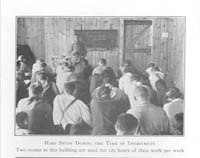 The second, and far more ambitious, goal of the YMCA was to make the war prisoners' incarceration rewarding.
By making the most of their prison confinement, each man would return home with enhanced skills that would
benefit the individual, his family, and society. This objective was reached through programs in education,
occupational training, and physical rehabilitation. Secretaries worked especially hard to establish school
systems in camps whenever possible. They recruited teachers from among the prisoners and offered wide-ranging
curricula. The Association designed university-level classes for college students, especially among the German,
French, and English inmates who had been drafted or recruited before they completed their degrees. The YMCA
set up extension classes with local colleges by recruiting faculty volunteers. At the other extreme, the
Association organized remedial reading courses for illiterate prisoners (approximately 80 percent of the Russian
and Serbian POWs could not read). Secretaries taught these inmates the alphabet and primary reading skills. In
addition, the YMCA established schools for boys, especially in Austria-Hungary, because large numbers of juveniles
followed their fathers into combat and were captured. They made special efforts to protect these boys, isolating
them from the general prison population and transferring them to central camps where they could receive an
education.7
The second, and far more ambitious, goal of the YMCA was to make the war prisoners' incarceration rewarding.
By making the most of their prison confinement, each man would return home with enhanced skills that would
benefit the individual, his family, and society. This objective was reached through programs in education,
occupational training, and physical rehabilitation. Secretaries worked especially hard to establish school
systems in camps whenever possible. They recruited teachers from among the prisoners and offered wide-ranging
curricula. The Association designed university-level classes for college students, especially among the German,
French, and English inmates who had been drafted or recruited before they completed their degrees. The YMCA
set up extension classes with local colleges by recruiting faculty volunteers. At the other extreme, the
Association organized remedial reading courses for illiterate prisoners (approximately 80 percent of the Russian
and Serbian POWs could not read). Secretaries taught these inmates the alphabet and primary reading skills. In
addition, the YMCA established schools for boys, especially in Austria-Hungary, because large numbers of juveniles
followed their fathers into combat and were captured. They made special efforts to protect these boys, isolating
them from the general prison population and transferring them to central camps where they could receive an
education.7
7
 Occupational training was an extension of the educational service of the YMCA. POWs learned skilled trades that
would increase their earning potential after the war. Many camps opened tanneries, tailor shops, book-binderies,
carpentry shops, shoe shops, and blacksmith foundries.
Occupational training was an extension of the educational service of the YMCA. POWs learned skilled trades that
would increase their earning potential after the war. Many camps opened tanneries, tailor shops, book-binderies,
carpentry shops, shoe shops, and blacksmith foundries.
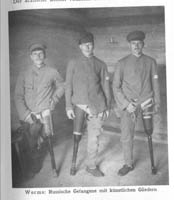 These shops also served a secondary, economic function: many of their products were in great demand and consumed
directly in the prison camps, or sold outside to provide industrious POWs with additional income. A special
target group was wounded and crippled prisoners. Secretaries encouraged amputees, who would be unable to return
to their pre-war occupations, to learn new trades so that they would not become a burden on their families and
society after their release. For example, the YMCA set up a special rehabilitation center at Wieselburg in
Hungary to help retrain trauma victims to ease their transition to civilian life.8
These shops also served a secondary, economic function: many of their products were in great demand and consumed
directly in the prison camps, or sold outside to provide industrious POWs with additional income. A special
target group was wounded and crippled prisoners. Secretaries encouraged amputees, who would be unable to return
to their pre-war occupations, to learn new trades so that they would not become a burden on their families and
society after their release. For example, the YMCA set up a special rehabilitation center at Wieselburg in
Hungary to help retrain trauma victims to ease their transition to civilian life.8
8
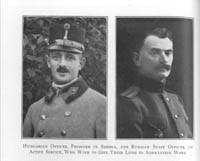 The last objective of the American YMCA was internally driven. The Association, through its work with POWs,
hoped to improve its reputation to gain access to areas of the world, which had previously resisted its entry.
These areas were primarily non-Protestant nations that were reluctant to authorize foreign missions by the
International Committee. Secretaries hoped to recruit future secretaries from the POW populations through the
Association program. These recruits would learn as much as they could about the YMCA during their incarceration
and return home to establish chapters. A more realistic goal was simply establishing name recognition among the
war prisoners. After the war, former POWs might be more receptive to YMCA missions, especially if the Association
had rendered them a valuable service during their captivity. Simultaneously, the YMCA got the chance to
demonstrate its humanitarian services to belligerent governments that had previously resisted the establishment
of Associations. These future missionary fields included Orthodox and Muslim countries, particularly Russia,
Serbia, Bulgaria, Romania, and Turkey, as well as Catholic countries such as France and Italy. War prisoner
service was a potential new force in the post-war expansion of Association work.9
The last objective of the American YMCA was internally driven. The Association, through its work with POWs,
hoped to improve its reputation to gain access to areas of the world, which had previously resisted its entry.
These areas were primarily non-Protestant nations that were reluctant to authorize foreign missions by the
International Committee. Secretaries hoped to recruit future secretaries from the POW populations through the
Association program. These recruits would learn as much as they could about the YMCA during their incarceration
and return home to establish chapters. A more realistic goal was simply establishing name recognition among the
war prisoners. After the war, former POWs might be more receptive to YMCA missions, especially if the Association
had rendered them a valuable service during their captivity. Simultaneously, the YMCA got the chance to
demonstrate its humanitarian services to belligerent governments that had previously resisted the establishment
of Associations. These future missionary fields included Orthodox and Muslim countries, particularly Russia,
Serbia, Bulgaria, Romania, and Turkey, as well as Catholic countries such as France and Italy. War prisoner
service was a potential new force in the post-war expansion of Association work.9
Harte Inaugurates Relief Work in Germany
9
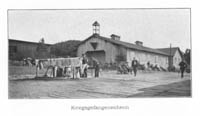 On 29 March 1915, ground was broken at Göttingen for the first YMCA war prison "hut" in the world.
Work on the building began on March 15, when Archibald C. Harte signed the contract for the lumber and
supplies. This building (measuring thirty feet by ninety feet) included a veranda, a small clock tower, a large
room (thirty feet by sixty feet), a library alcove, a smaller room (fifteen feet by twenty-four feet) for lectures, choir, or
orchestra rehearsals, and three small rooms for classes. The hut served as the social, educational, and
religious center of the camp. It cost the American YMCA six thousand Marks to construct, or fifteen cents per
inmate. The prisoners provided the labor for the construction and carpentry work. The hut was scheduled
for completion on April 15, when its formal inauguration would be celebrated.10
On 29 March 1915, ground was broken at Göttingen for the first YMCA war prison "hut" in the world.
Work on the building began on March 15, when Archibald C. Harte signed the contract for the lumber and
supplies. This building (measuring thirty feet by ninety feet) included a veranda, a small clock tower, a large
room (thirty feet by sixty feet), a library alcove, a smaller room (fifteen feet by twenty-four feet) for lectures, choir, or
orchestra rehearsals, and three small rooms for classes. The hut served as the social, educational, and
religious center of the camp. It cost the American YMCA six thousand Marks to construct, or fifteen cents per
inmate. The prisoners provided the labor for the construction and carpentry work. The hut was scheduled
for completion on April 15, when its formal inauguration would be celebrated.10
10
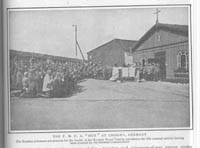 The establishment of an Association hut at Crossen-an-der-Oder was also in progress at the same time.
Harte ordered equipment for the reading room, which included fifty board tables, two hundred benches,
a map, a clock, a blackboard, and a small library. Relief work at this camp would focus on the welfare
of Russian POWs. An inauguration ceremony would follow in April.11
The establishment of an Association hut at Crossen-an-der-Oder was also in progress at the same time.
Harte ordered equipment for the reading room, which included fifty board tables, two hundred benches,
a map, a clock, a blackboard, and a small library. Relief work at this camp would focus on the welfare
of Russian POWs. An inauguration ceremony would follow in April.11
11
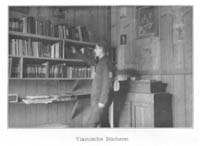 While construction proceeded at Göttingen, Harte worked with the POWs. He preached before a packed
barrack room and, although there were no hymn-books, the singing was enthusiastic. After the service,
Harte met with the non-commissioned officers who would supervise the new organization. They agreed that
the prisoners who wished to become members should pay a monthly fifteen Pfennig fee (the Association firmly
believed that free services were never appreciated and enjoyed as much as paid services; even a small fee
was important, since it helped members feel that they were contributing to their own welfare program). They
also made plans for an English, French, and Russian library, choirs, an orchestra, and a school. Professor
Carl Stange, of the University of Göttingen, agreed to teach a German class composed of twenty-one
sergeants; they would then teach the enlisted men. Eventually, classes in French and Russian would follow.
Harte planned the English library, well stocked with religious works. He obtained five hundred hymnals, one thousand
Testaments and Bibles, simple Bible study books, a Bible dictionary, a commentary, and other general books.
Harte purchased similar materials in other languages as they became available.
While construction proceeded at Göttingen, Harte worked with the POWs. He preached before a packed
barrack room and, although there were no hymn-books, the singing was enthusiastic. After the service,
Harte met with the non-commissioned officers who would supervise the new organization. They agreed that
the prisoners who wished to become members should pay a monthly fifteen Pfennig fee (the Association firmly
believed that free services were never appreciated and enjoyed as much as paid services; even a small fee
was important, since it helped members feel that they were contributing to their own welfare program). They
also made plans for an English, French, and Russian library, choirs, an orchestra, and a school. Professor
Carl Stange, of the University of Göttingen, agreed to teach a German class composed of twenty-one
sergeants; they would then teach the enlisted men. Eventually, classes in French and Russian would follow.
Harte planned the English library, well stocked with religious works. He obtained five hundred hymnals, one thousand
Testaments and Bibles, simple Bible study books, a Bible dictionary, a commentary, and other general books.
Harte purchased similar materials in other languages as they became available.
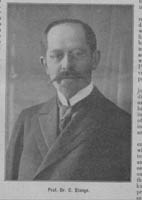 As soon as the building was opened, the American YMCA would send additional equipment. Harte requested that
the International Committee send all possible news, including programs, menus, and photographs (which could
quickly pass through German censors). He also acquired a piano, a harmonium, tables, benches, blackboards,
maps, and pictures to support the educational program. He felt that the organization also required carbolic
soap, tinned meats, fruit, cheese, socks, shoes, underwear, biscuits, preserved fruits, chocolate, and tobacco.
In addition, the commandant approved the erection of a monument to the dead in the camp cemetery. Funds for
the construction came from the prisoners.12
As soon as the building was opened, the American YMCA would send additional equipment. Harte requested that
the International Committee send all possible news, including programs, menus, and photographs (which could
quickly pass through German censors). He also acquired a piano, a harmonium, tables, benches, blackboards,
maps, and pictures to support the educational program. He felt that the organization also required carbolic
soap, tinned meats, fruit, cheese, socks, shoes, underwear, biscuits, preserved fruits, chocolate, and tobacco.
In addition, the commandant approved the erection of a monument to the dead in the camp cemetery. Funds for
the construction came from the prisoners.12
12
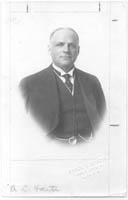 With permission from the Germans to begin Association work in prison camps, Harte had to establish an
organization to supervise operations. The World's Committee of the World's Alliance of YMCAs recommended that
POW work be undertaken by Swiss secretaries. The English National YMCA Council opposed this plan, however,
unless these secretaries worked directly under their jurisdiction. The International Committee in New York
initially supported having American secretaries work under the auspices of the World's Committee to emphasize
the neutral and international character of POW relief. The initial agreements between Mott and several members
of the World's Committee in early 1915 reflected the American YMCA's willingness to work under the World's
Alliance, but Harte determined this might create political problems. He concluded that German authorities were
suspicious of the neutral spirit of the World's Committee, and the German National YMCA Council expressed
reservations about working with the Geneva-based group. As a result, Harte recommended that the International
Committee send money and assign personnel under the jurisdiction of the national
YMCA Councils in each country. Association secretaries from these countries could freely enter prison camps, and
they would provide a service to their enemies, which would be appreciated after the war and improve international
relations. The national YMCA Council in each country would undertake relief work for POWs
where the authorities agreed to grant access to war prison camps. If a given national Council could not support
this work, especially if there were financial constraints, then the work should be organized as an affiliated
service to the national YMCA Council. In this event, the work would be assigned to the World's Committee, but under the purview of a
special sub-committee working under an international umbrella organization. In each country, Mott felt, POW
relief should be supervised by a small committee appointed by the chairman of the national YMCA Council and
the work supervised by a trained Red Triangle secretary. Wherever possible, Association workers should be citizens or
subjects of the country in which they worked, and any neutral secretaries had to receive full approval from
the Ministry of War of that country. This organizational plan had promise in theory, but would have to be
modified in practice.13
With permission from the Germans to begin Association work in prison camps, Harte had to establish an
organization to supervise operations. The World's Committee of the World's Alliance of YMCAs recommended that
POW work be undertaken by Swiss secretaries. The English National YMCA Council opposed this plan, however,
unless these secretaries worked directly under their jurisdiction. The International Committee in New York
initially supported having American secretaries work under the auspices of the World's Committee to emphasize
the neutral and international character of POW relief. The initial agreements between Mott and several members
of the World's Committee in early 1915 reflected the American YMCA's willingness to work under the World's
Alliance, but Harte determined this might create political problems. He concluded that German authorities were
suspicious of the neutral spirit of the World's Committee, and the German National YMCA Council expressed
reservations about working with the Geneva-based group. As a result, Harte recommended that the International
Committee send money and assign personnel under the jurisdiction of the national
YMCA Councils in each country. Association secretaries from these countries could freely enter prison camps, and
they would provide a service to their enemies, which would be appreciated after the war and improve international
relations. The national YMCA Council in each country would undertake relief work for POWs
where the authorities agreed to grant access to war prison camps. If a given national Council could not support
this work, especially if there were financial constraints, then the work should be organized as an affiliated
service to the national YMCA Council. In this event, the work would be assigned to the World's Committee, but under the purview of a
special sub-committee working under an international umbrella organization. In each country, Mott felt, POW
relief should be supervised by a small committee appointed by the chairman of the national YMCA Council and
the work supervised by a trained Red Triangle secretary. Wherever possible, Association workers should be citizens or
subjects of the country in which they worked, and any neutral secretaries had to receive full approval from
the Ministry of War of that country. This organizational plan had promise in theory, but would have to be
modified in practice.13
13
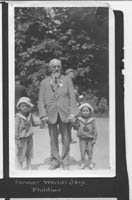 Harte's decision to set up POW relief committees through national YMCA Councils rather than under the auspices
of the World's Alliance of YMCAs led to a serious disagreement with Christian Phildius. The World's Committee
General Secretary wrote to Mott about the disagreement in April 1915. Friction between the two Association
secretaries began in March, when the World's Committee published an article that incorrectly stated that Harte
had been sent to Germany to work solely with British POWs. Harte responded with a strong letter of protest,
since such reporting undermined his bargaining position with the Russian and Austro-Hungarian governments.
Phildius concluded that Harte was firmly under the strong influence of Gerhard Niedermeyer, the National
Secretary of the German Student Christian Movement. As a result, Harte had placed POW relief work into the
hands of the German National YMCA Committee, excluding the World's Committee, which seriously weakened the
Geneva organization. More importantly, Phildius believed Niedermeyer was "not internationally inclined," which
augmented the problem. Instead, Phildius praised Carlisle V. Hibbard, because he "worked harmoniously with the
World's Committee." This marked the beginning of a rift between Harte and the World's Alliance, since Harte
declined to travel to Geneva to address the misunderstanding. This disagreement would continue to fester, and
expanded tremendously after the U.S. entered the war.14
Harte's decision to set up POW relief committees through national YMCA Councils rather than under the auspices
of the World's Alliance of YMCAs led to a serious disagreement with Christian Phildius. The World's Committee
General Secretary wrote to Mott about the disagreement in April 1915. Friction between the two Association
secretaries began in March, when the World's Committee published an article that incorrectly stated that Harte
had been sent to Germany to work solely with British POWs. Harte responded with a strong letter of protest,
since such reporting undermined his bargaining position with the Russian and Austro-Hungarian governments.
Phildius concluded that Harte was firmly under the strong influence of Gerhard Niedermeyer, the National
Secretary of the German Student Christian Movement. As a result, Harte had placed POW relief work into the
hands of the German National YMCA Committee, excluding the World's Committee, which seriously weakened the
Geneva organization. More importantly, Phildius believed Niedermeyer was "not internationally inclined," which
augmented the problem. Instead, Phildius praised Carlisle V. Hibbard, because he "worked harmoniously with the
World's Committee." This marked the beginning of a rift between Harte and the World's Alliance, since Harte
declined to travel to Geneva to address the misunderstanding. This disagreement would continue to fester, and
expanded tremendously after the U.S. entered the war.14
14
 On 3 April 1915, Harte returned to Berlin for a conference of German officials and began to organize POW
relief work. At this initial meeting, he met with a member of the Ministry of War and three professors from
Göttingen, Hannoverisch-Münden, and Cassel. This group had studied the POW system in Germany with
a goal of making improvements. Caring for almost one million war prisoners taxed the German economy. The Germans
had to guard, house, clothe, and feed these men, along with providing essential services such as post offices,
hospitals, baths, laundries, bakeries, tailors, shoemakers, ministers, and priests. Harte was convinced that
these men were striving to improve the situation of Allied POWs in a genuinely
On 3 April 1915, Harte returned to Berlin for a conference of German officials and began to organize POW
relief work. At this initial meeting, he met with a member of the Ministry of War and three professors from
Göttingen, Hannoverisch-Münden, and Cassel. This group had studied the POW system in Germany with
a goal of making improvements. Caring for almost one million war prisoners taxed the German economy. The Germans
had to guard, house, clothe, and feed these men, along with providing essential services such as post offices,
hospitals, baths, laundries, bakeries, tailors, shoemakers, ministers, and priests. Harte was convinced that
these men were striving to improve the situation of Allied POWs in a genuinely
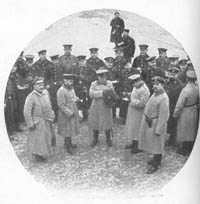 humanitarian spirit. This group also wished to advance "real German Kultur" to these men to disseminate
German ideas among the POWs. While somewhat suspicious of this objective, Harte presented the discussion in the
best possible light in his reports. By May 1915, Harte and the German YMCA had organized POW relief work on a
more formal basis. The National Committee of the German YMCA had set up a Prisoner of War Committee to supervise
relief work in the prison camps. G. Rosenkranz, a factory owner from Barmen, served as president of this committee.
Other members included Pastor Berlin as vice president; Meyer as secretary; Captain W. von Lübbers as the
Ministry of War representative; Niedermeyer of the German Student Christian Movement; and Harte. This committee,
the War Prisoners' Aid of the YMCA (WPA), secured patrons to support POW relief work, collect books, study
additional avenues of work, and assist prisoners wherever possible. The German YMCA provided an office for the
WPA headquarters in Berlin.15
humanitarian spirit. This group also wished to advance "real German Kultur" to these men to disseminate
German ideas among the POWs. While somewhat suspicious of this objective, Harte presented the discussion in the
best possible light in his reports. By May 1915, Harte and the German YMCA had organized POW relief work on a
more formal basis. The National Committee of the German YMCA had set up a Prisoner of War Committee to supervise
relief work in the prison camps. G. Rosenkranz, a factory owner from Barmen, served as president of this committee.
Other members included Pastor Berlin as vice president; Meyer as secretary; Captain W. von Lübbers as the
Ministry of War representative; Niedermeyer of the German Student Christian Movement; and Harte. This committee,
the War Prisoners' Aid of the YMCA (WPA), secured patrons to support POW relief work, collect books, study
additional avenues of work, and assist prisoners wherever possible. The German YMCA provided an office for the
WPA headquarters in Berlin.15
15
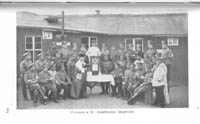 By April 13, Harte had the beginnings of a POW relief program well established in Germany. Work was about
to begin at Göttingen, primarily for French and Belgian prisoners; it was well under way at
Crossen-an-der-Oder for Russian POWs; and was planned for Allied prisoners at Hannoverisch-Münden. The
American secretary also planned operations at the POW camp at Sennelager for British POWs. German YMCA workers
were free to enter prison camps, and enthusiastically provided services for Allied POWs. This work, it was hoped,
would help restore amity between nations after the war, as Germans aided Englishmen, Belgians, Frenchmen, and
Russians in prison camps. This work grew out of the ideology of Christian Internationalism, which advocated that
national barriers be broken down to extend service to one's fellow men.16
By April 13, Harte had the beginnings of a POW relief program well established in Germany. Work was about
to begin at Göttingen, primarily for French and Belgian prisoners; it was well under way at
Crossen-an-der-Oder for Russian POWs; and was planned for Allied prisoners at Hannoverisch-Münden. The
American secretary also planned operations at the POW camp at Sennelager for British POWs. German YMCA workers
were free to enter prison camps, and enthusiastically provided services for Allied POWs. This work, it was hoped,
would help restore amity between nations after the war, as Germans aided Englishmen, Belgians, Frenchmen, and
Russians in prison camps. This work grew out of the ideology of Christian Internationalism, which advocated that
national barriers be broken down to extend service to one's fellow men.16
The Inauguration of the Association Building at Göttingen
16
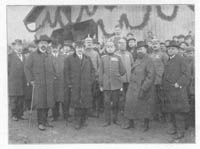 American YMCA POW work officially began on 15 April 1915, when the Association hut was inaugurated at
Göttingen. Ambassador James W. Gerard, Vincente Palmaroli (the Spanish consul representing the ambassador),
Dr. Karl Ohnesorg (U.S. Naval Attaché), Meyer (Director of the National Committee of the YMCAs of Germany),
Niedermeyer (General Secretary of the German Christian Student Movement), Professor Stange, Reverend A. W.
Schreiber, Phildius, and Harte plus many other pastors, professors, and
American YMCA POW work officially began on 15 April 1915, when the Association hut was inaugurated at
Göttingen. Ambassador James W. Gerard, Vincente Palmaroli (the Spanish consul representing the ambassador),
Dr. Karl Ohnesorg (U.S. Naval Attaché), Meyer (Director of the National Committee of the YMCAs of Germany),
Niedermeyer (General Secretary of the German Christian Student Movement), Professor Stange, Reverend A. W.
Schreiber, Phildius, and Harte plus many other pastors, professors, and
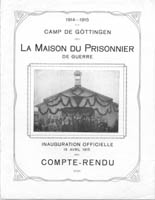 Christian workers attended the official opening of the YMCA building, making the occasion an international event. American and
Spanish diplomatic officials participated as representatives of the Allied nations. But more importantly,
Harte's speech focused on the opportunities such a facility presented for Christian Internationalism, a
"world-wide brotherhood of young men." Through the joint effort of the Ministry of War, the German YMCA
National Committee, and the American YMCA, this building was dedicated: "…for the young men of Belgium,
Flanders, France, Great Britain, and Russia, [and] is a witness of a relation that lies deeper than race,
nationality, and circumstances."17
Christian workers attended the official opening of the YMCA building, making the occasion an international event. American and
Spanish diplomatic officials participated as representatives of the Allied nations. But more importantly,
Harte's speech focused on the opportunities such a facility presented for Christian Internationalism, a
"world-wide brotherhood of young men." Through the joint effort of the Ministry of War, the German YMCA
National Committee, and the American YMCA, this building was dedicated: "…for the young men of Belgium,
Flanders, France, Great Britain, and Russia, [and] is a witness of a relation that lies deeper than race,
nationality, and circumstances."17
17 Harte warned that:
No man can leave this war prison the same man that he entered. Every man here will either acquire or strengthen habits of idleness and daily deteriorate, and, when peace is declared, go out slouching and growling a ruined man, asking to be taken care of by his country, his friends, or even by his mother or siblings; or he will acquire or strengthen habits of seeking knowledge, of serving his fellowmen, and of making friends that will so enrich him, that he will go out to be in a new sense a benefactor of his home, his country, and his generation.18
18
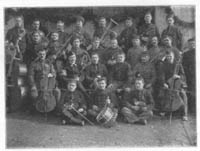 The American secretary urged the prisoners to use this center to develop a commitment to culture, service,
and friendship. In their leisure time, they could appreciate new cultures by acquiring new languages; study
the manners, customs, and histories of other people; and learn new arts and skills. The Association hut
offered a library, musical instruments, study and conference rooms, and a hall for sermons, lectures, and
concerts, which (it was hoped) would help the POWs understand the expanded cultural offerings that were now
available to them. POWs were to develop the habit of thinking first of the needs of their companions and
The American secretary urged the prisoners to use this center to develop a commitment to culture, service,
and friendship. In their leisure time, they could appreciate new cultures by acquiring new languages; study
the manners, customs, and histories of other people; and learn new arts and skills. The Association hut
offered a library, musical instruments, study and conference rooms, and a hall for sermons, lectures, and
concerts, which (it was hoped) would help the POWs understand the expanded cultural offerings that were now
available to them. POWs were to develop the habit of thinking first of the needs of their companions and
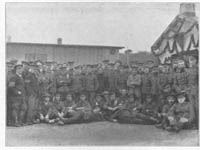 learning how to meet those needs, "For the man who had learned this lesson and practiced it cannot be
unhappy, and must daily attain unto the stature of the perfect man." Finally, service was described as
being "the royal way to friendship, for the man who thinks most of others and serves most will have the
most friends." By making friends with companions, officers, and guards, POWs would discover the bright side
of life in a war prison. This philosophy was the foundation of the Association's POW relief service; that
captivity should not be wasted in self-pity, but instead viewed as an opportunity for POWs to learn new
trades, develop better skills, and take advantage of educational opportunities. Not only would they benefit
as individuals, but they also had a chance to help their communities when they returned home.19
learning how to meet those needs, "For the man who had learned this lesson and practiced it cannot be
unhappy, and must daily attain unto the stature of the perfect man." Finally, service was described as
being "the royal way to friendship, for the man who thinks most of others and serves most will have the
most friends." By making friends with companions, officers, and guards, POWs would discover the bright side
of life in a war prison. This philosophy was the foundation of the Association's POW relief service; that
captivity should not be wasted in self-pity, but instead viewed as an opportunity for POWs to learn new
trades, develop better skills, and take advantage of educational opportunities. Not only would they benefit
as individuals, but they also had a chance to help their communities when they returned home.19
19
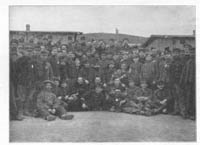 The program included performances by the camp's newly organized choir and orchestra, as well as speeches by
Colonel Bogen, Harte, Stange, and British, French, and Belgian prisoners. Then the Association building was
officially declared open, and
The program included performances by the camp's newly organized choir and orchestra, as well as speeches by
Colonel Bogen, Harte, Stange, and British, French, and Belgian prisoners. Then the Association building was
officially declared open, and
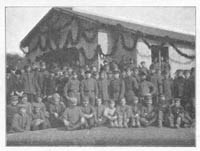 the Association's work could begin. Stange had already enlisted other professors at the University of
Göttingen to offer classes to the POWs. They gave lectures, organized courses, and contributed to the
camp library. The prisoners also began a garden in front of the building. As Harte observed, "the chief
charm of the whole affair was the sense of ownership and comradeship constantly in evidence."20
the Association's work could begin. Stange had already enlisted other professors at the University of
Göttingen to offer classes to the POWs. They gave lectures, organized courses, and contributed to the
camp library. The prisoners also began a garden in front of the building. As Harte observed, "the chief
charm of the whole affair was the sense of ownership and comradeship constantly in evidence."20
20
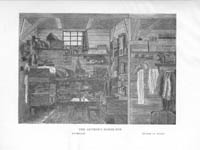 The Wilson Administration's strong support for the American YMCA's POW relief work in Germany was clear after
the Göttingen inauguration. Ambassador Gerard enthusiastically supported Harte's work and readily accepted
the YMCA's invitation to participate in the Göttingen ceremony. Gerard even attempted to persuade the
Spanish ambassador to accompany him to the inauguration to add even more diplomatic prestige. In letters to
Mott, the U.S. Ambassador praised the hard work and effort Harte put into his mission. Gerard declared: "I
congratulate you on the idea and hope that you and your American friends will extend this work to the prison
camps throughout the world."21 After the hut was
opened, Secretary of State William Jennings Bryan cabled the International Committee to congratulate the
American YMCA on its efforts to aid Allied POWs. Bryan described this work as being "of inestimable
The Wilson Administration's strong support for the American YMCA's POW relief work in Germany was clear after
the Göttingen inauguration. Ambassador Gerard enthusiastically supported Harte's work and readily accepted
the YMCA's invitation to participate in the Göttingen ceremony. Gerard even attempted to persuade the
Spanish ambassador to accompany him to the inauguration to add even more diplomatic prestige. In letters to
Mott, the U.S. Ambassador praised the hard work and effort Harte put into his mission. Gerard declared: "I
congratulate you on the idea and hope that you and your American friends will extend this work to the prison
camps throughout the world."21 After the hut was
opened, Secretary of State William Jennings Bryan cabled the International Committee to congratulate the
American YMCA on its efforts to aid Allied POWs. Bryan described this work as being "of inestimable  value" and hoped that similar relief operations could be extended to all prison camps. Both Gerard and Bryan
forwarded Harte's reports from Germany through diplomatic channels. In addition, Gerard sent photographs taken
by Harte of German prison camps. German military censors approved the photos for publication in American
magazines and newspapers, which gave the YMCA program even greater publicity. Harte was adept at using
photography-and even motion pictures-to portray prison life, and to highlight ways that the Association could
improve POW living standards. From the State Department's perspective, the American YMCA's humanitarian efforts
for POWs of all nations strengthened the United States' neutrality policy, and effectively counter-balanced
growing German criticism of American munitions sales to the Allies, war loan negotiations, and British
interception of foreign mail.22
value" and hoped that similar relief operations could be extended to all prison camps. Both Gerard and Bryan
forwarded Harte's reports from Germany through diplomatic channels. In addition, Gerard sent photographs taken
by Harte of German prison camps. German military censors approved the photos for publication in American
magazines and newspapers, which gave the YMCA program even greater publicity. Harte was adept at using
photography-and even motion pictures-to portray prison life, and to highlight ways that the Association could
improve POW living standards. From the State Department's perspective, the American YMCA's humanitarian efforts
for POWs of all nations strengthened the United States' neutrality policy, and effectively counter-balanced
growing German criticism of American munitions sales to the Allies, war loan negotiations, and British
interception of foreign mail.22
21
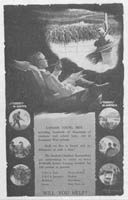 With access to German prison camps, Harte put the next step of the Association program into effect. Trained
YMCA secretaries needed to be assigned to visit prison camps, to organize committees, and to support relief
operations. Since he was still negotiating with belligerent governments, Harte requested the International
Committee dispatch German-speaking American secretaries for work in Germany. Through the U.S. embassy, Harte
asked for two secretaries for immediate work. One would supervise shipments and correspondence, while the
other would conduct field-work among POWs. Harte hoped that two or three workers would be in Germany by
August to get relief operations underway.23
With access to German prison camps, Harte put the next step of the Association program into effect. Trained
YMCA secretaries needed to be assigned to visit prison camps, to organize committees, and to support relief
operations. Since he was still negotiating with belligerent governments, Harte requested the International
Committee dispatch German-speaking American secretaries for work in Germany. Through the U.S. embassy, Harte
asked for two secretaries for immediate work. One would supervise shipments and correspondence, while the
other would conduct field-work among POWs. Harte hoped that two or three workers would be in Germany by
August to get relief operations underway.23
22
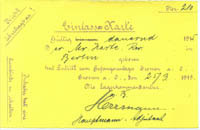 Before Harte departed on his second trip to Russia, he visited the British civilian internment camp at
Ruhleben in September 1915. He was able to inspect the camp and freely talk with the prisoners, whom he
found "in good health and had no desires that I could gratify." The prison grounds were large, and the
internees had access to excellent athletic facilities; in addition, the camp featured a good canteen, and
the POWs had established several social organizations. The prisoners had an orchestra, dramatic club,
choir, weekly church services, and a large library. The camp school system had 1,200 prisoners enrolled in
150 classes. Harte asked the military authorities to construct a large Association hut for social and
educational programs. The commandant immediately granted the request, and the building was swiftly erected.
It became the social center of the prison, and many inmates survived the war by participating in the Association
program.24
Before Harte departed on his second trip to Russia, he visited the British civilian internment camp at
Ruhleben in September 1915. He was able to inspect the camp and freely talk with the prisoners, whom he
found "in good health and had no desires that I could gratify." The prison grounds were large, and the
internees had access to excellent athletic facilities; in addition, the camp featured a good canteen, and
the POWs had established several social organizations. The prisoners had an orchestra, dramatic club,
choir, weekly church services, and a large library. The camp school system had 1,200 prisoners enrolled in
150 classes. Harte asked the military authorities to construct a large Association hut for social and
educational programs. The commandant immediately granted the request, and the building was swiftly erected.
It became the social center of the prison, and many inmates survived the war by participating in the Association
program.24
23
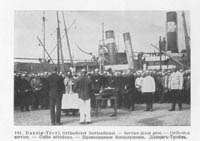 In late September 1915, the Ministry of War approved Harte's request for four neutral secretaries to begin
welfare operations in Germany and announced that they would accept additional secretaries. The theoretical
organizational plan Harte had developed in March 1915 had problems in application. Under the original plan,
WPA work would be carried out by national YMCA Committees employing secretaries from their respective countries.
But Harte and Hibbard realized that it would be impossible to win the confidence of the British and French
governments if reports about prison camp conditions in Germany were written by German Association secretaries.
The German government would find reports written by English or French secretaries equally suspicious. Only the
absolute neutrality of American secretaries and the reciprocal program of the American YMCA mission could lend
credibility to these reports. As a result, the American YMCA needed American and other neutral secretaries to
enact the WPA program.25
In late September 1915, the Ministry of War approved Harte's request for four neutral secretaries to begin
welfare operations in Germany and announced that they would accept additional secretaries. The theoretical
organizational plan Harte had developed in March 1915 had problems in application. Under the original plan,
WPA work would be carried out by national YMCA Committees employing secretaries from their respective countries.
But Harte and Hibbard realized that it would be impossible to win the confidence of the British and French
governments if reports about prison camp conditions in Germany were written by German Association secretaries.
The German government would find reports written by English or French secretaries equally suspicious. Only the
absolute neutrality of American secretaries and the reciprocal program of the American YMCA mission could lend
credibility to these reports. As a result, the American YMCA needed American and other neutral secretaries to
enact the WPA program.25
The First American Secretaries Enter the Field in Germany
24
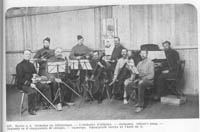 When Conrad Hoffman entered the field in September 1915, he was the pioneer of WPA work in Germany. He
received a Ministry of War permit-signed by the prison camp system commander, General Friedrich-which entitled
Hoffman to visit all POW camps and hospitals in Prussia; converse freely and unhampered with Allied prisoners,
without a German interpreter or official;
When Conrad Hoffman entered the field in September 1915, he was the pioneer of WPA work in Germany. He
received a Ministry of War permit-signed by the prison camp system commander, General Friedrich-which entitled
Hoffman to visit all POW camps and hospitals in Prussia; converse freely and unhampered with Allied prisoners,
without a German interpreter or official;
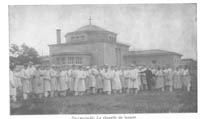 and to take notes and photographs of the POWs and camp equipment. The American secretary could also exchange
food and clothing for the benefit of Allied prisoners, as well as carry mail. This permit gave Hoffman unusual
freedom of action in the prison camps, but it did not eliminate all bureaucratic obstacles. Camp commandants
could deny Hoffman access to prison camps unless he received a permit from the Army Corps Command staff (there
were nineteen corps headquarters in Prussia).
and to take notes and photographs of the POWs and camp equipment. The American secretary could also exchange
food and clothing for the benefit of Allied prisoners, as well as carry mail. This permit gave Hoffman unusual
freedom of action in the prison camps, but it did not eliminate all bureaucratic obstacles. Camp commandants
could deny Hoffman access to prison camps unless he received a permit from the Army Corps Command staff (there
were nineteen corps headquarters in Prussia).
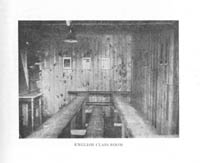 The Berlin permit also did not allow Hoffman access to prison camps in Bavaria, Saxony, or Württemberg.
To visit these facilities, Hoffman needed special permits from the Ministries of War from each kingdom, plus
Army Corps Commands, if required. In practice, Hoffman needed a Ministry of War permit, an Army Corps Command permit, and an
Inspector of the Army Corps letter of reference; he also had to notify the camp commandant of his intention
to visit before arriving at each prison camp. Shortly after his arrival in Germany, Hoffman was joined by
another member of the Flying Squadron, James E. Sprunger. A Swedish YMCA secretary, Reverend H. Neander,
arrived in Germany on 1 October 1915. He was paid by the International Committee and served with the American
WPA secretaries until his departure on 1 January 1916. These secretaries were the nucleus of the Red Triangle's
WPA program in Germany.26
The Berlin permit also did not allow Hoffman access to prison camps in Bavaria, Saxony, or Württemberg.
To visit these facilities, Hoffman needed special permits from the Ministries of War from each kingdom, plus
Army Corps Commands, if required. In practice, Hoffman needed a Ministry of War permit, an Army Corps Command permit, and an
Inspector of the Army Corps letter of reference; he also had to notify the camp commandant of his intention
to visit before arriving at each prison camp. Shortly after his arrival in Germany, Hoffman was joined by
another member of the Flying Squadron, James E. Sprunger. A Swedish YMCA secretary, Reverend H. Neander,
arrived in Germany on 1 October 1915. He was paid by the International Committee and served with the American
WPA secretaries until his departure on 1 January 1916. These secretaries were the nucleus of the Red Triangle's
WPA program in Germany.26
25
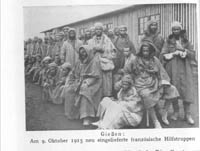 The liberal terms of the Ministry of War permit combined with the bureaucratic hurdles imposed on Hoffman
resulted in other problems as well. To Germans engaged in a total war, any neutral citizen was a target of
suspicion. But for the Allied POWs, a neutral official carrying imperial papers was a possible German agent,
sent to spy and report on their activities
The liberal terms of the Ministry of War permit combined with the bureaucratic hurdles imposed on Hoffman
resulted in other problems as well. To Germans engaged in a total war, any neutral citizen was a target of
suspicion. But for the Allied POWs, a neutral official carrying imperial papers was a possible German agent,
sent to spy and report on their activities
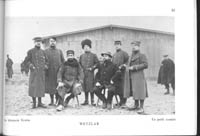 and complaints. Breaking the ice with Allied POWs was Hoffman's first important challenge, and it was
an initial obstacle in terms of gaining the trust of the prisoners. Association WPA work was a unique
social welfare operation. Most relief agencies worked from the outside, sending in supplies and equipment
but not developing personal relationships with the prisoners, apart from the camp relief committees. The
YMCA always emphasized the personal element as the most important
and complaints. Breaking the ice with Allied POWs was Hoffman's first important challenge, and it was
an initial obstacle in terms of gaining the trust of the prisoners. Association WPA work was a unique
social welfare operation. Most relief agencies worked from the outside, sending in supplies and equipment
but not developing personal relationships with the prisoners, apart from the camp relief committees. The
YMCA always emphasized the personal element as the most important
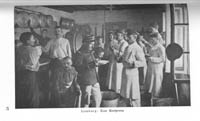 factor in establishing relief programs in prison camps. The Red Triangle worker's slogan was "Helping men
to help themselves." Each secretary also had to overcome sectarian prejudices among the POWs. The YMCA was
a Protestant organization-Catholic and Orthodox prisoners were suspicious of the agency's objectives. Under
the agreement with the German government, secretaries could not conduct propaganda work, although they could
organize interdenominational meetings. It was important for American secretaries to emphasize that Red Triangle
service was for all war prisoners, irrespective of nationality or religious creed. They needed unusual
diplomatic skills to win and keep the confidence of German officers and guards as well as the POWs, but this was
an essential prerequisite for successful WPA work.27
factor in establishing relief programs in prison camps. The Red Triangle worker's slogan was "Helping men
to help themselves." Each secretary also had to overcome sectarian prejudices among the POWs. The YMCA was
a Protestant organization-Catholic and Orthodox prisoners were suspicious of the agency's objectives. Under
the agreement with the German government, secretaries could not conduct propaganda work, although they could
organize interdenominational meetings. It was important for American secretaries to emphasize that Red Triangle
service was for all war prisoners, irrespective of nationality or religious creed. They needed unusual
diplomatic skills to win and keep the confidence of German officers and guards as well as the POWs, but this was
an essential prerequisite for successful WPA work.27
26
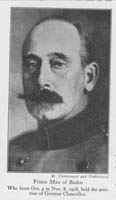 Armed with their Ministry of War permits, Hoffman and Sprunger toured German prison camps extensively
in western Germany, starting on 2 October 1915. They first visited the military hospital at Halle-am-Saale in Prussian Saxony. They then proceeded to Carlsruhe, the capital of the Grand Duchy of Baden.
Hoffman and Sprunger had a friendly and informal meeting with the heir to the duchy and future Chancellor
of the German Empire, Prince Max. Harte advised Hoffman to ask the prince to serve as the patron of the
YMCA's WPA work in Germany.
The prince was deeply interested in POW relief work, and was already intensely involved in providing welfare programs for prisoners of war.
Armed with their Ministry of War permits, Hoffman and Sprunger toured German prison camps extensively
in western Germany, starting on 2 October 1915. They first visited the military hospital at Halle-am-Saale in Prussian Saxony. They then proceeded to Carlsruhe, the capital of the Grand Duchy of Baden.
Hoffman and Sprunger had a friendly and informal meeting with the heir to the duchy and future Chancellor
of the German Empire, Prince Max. Harte advised Hoffman to ask the prince to serve as the patron of the
YMCA's WPA work in Germany.
The prince was deeply interested in POW relief work, and was already intensely involved in providing welfare programs for prisoners of war.
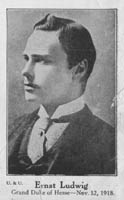 Prince Max graciously agreed to lead the
committee. The Americans' next stop was Darmstadt, the capital of the Grand Duchy of Hesse-Darmstadt. They
enjoyed an informal meeting with Grand Duke Ernst Ludwig. The grand duke, who spoke English and whose
mother was a British princess, showed deep interest in YMCA work and arranged for his adjutant to take them
on a tour of Hessian prison camps. The next day, the American secretaries toured several hospitals and camps
near Darmstadt.
They inspected a military hospital for French and Russian prisoners, a quarantine compound,
delousing buildings, and prison compounds featuring kitchens, canteens, reading rooms, playgrounds, a
theater, workshops (shoemaker, tailor, carpentry, and art studios), a church barrack, vegetable and flower
gardens, and drainage and sewage systems. Hoffman determined that the Germans had nothing to hide, and was
impressed with German efficiency and organization. He praised German Kultur, and the commandants'
benevolence to Allied POWs. A degree of rivalry between camp commanders also improved the lot of
prisoners.28
Prince Max graciously agreed to lead the
committee. The Americans' next stop was Darmstadt, the capital of the Grand Duchy of Hesse-Darmstadt. They
enjoyed an informal meeting with Grand Duke Ernst Ludwig. The grand duke, who spoke English and whose
mother was a British princess, showed deep interest in YMCA work and arranged for his adjutant to take them
on a tour of Hessian prison camps. The next day, the American secretaries toured several hospitals and camps
near Darmstadt.
They inspected a military hospital for French and Russian prisoners, a quarantine compound,
delousing buildings, and prison compounds featuring kitchens, canteens, reading rooms, playgrounds, a
theater, workshops (shoemaker, tailor, carpentry, and art studios), a church barrack, vegetable and flower
gardens, and drainage and sewage systems. Hoffman determined that the Germans had nothing to hide, and was
impressed with German efficiency and organization. He praised German Kultur, and the commandants'
benevolence to Allied POWs. A degree of rivalry between camp commanders also improved the lot of
prisoners.28
27
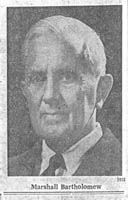 Hoffman and Sprunger then traveled to visit the prison camps at Giessen and Wetzlar. At Giessen, Hoffman
took pity on the colonial prisoners. He was moved by a Senegalese prisoner, stranded in a strange country
and far from home, and by an Indian soldier who spoke and understood only a native dialect. They then
continued to the POW camp at Limburg-am-Lahn, which held ten thousand men. Over half of the prisoners were sent
out of the camp to work in the local fields. Hoffman and Sprunger visited the censor office, which was
inspecting parcels, and the parcel delivery service, which forwarded packages to transferred prisoners.
Hoffman and Sprunger then traveled to visit the prison camps at Giessen and Wetzlar. At Giessen, Hoffman
took pity on the colonial prisoners. He was moved by a Senegalese prisoner, stranded in a strange country
and far from home, and by an Indian soldier who spoke and understood only a native dialect. They then
continued to the POW camp at Limburg-am-Lahn, which held ten thousand men. Over half of the prisoners were sent
out of the camp to work in the local fields. Hoffman and Sprunger visited the censor office, which was
inspecting parcels, and the parcel delivery service, which forwarded packages to transferred prisoners.
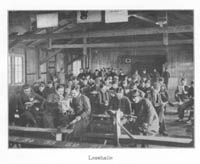 At the Russian POW camp in Worms, the prisoners had a special barrack for religious services and an
excellent hospital. The German officials at this camp strongly encouraged the establishment of Association
work, and Sprunger believed that this presented an opportunity to set up an educational program. Hoffman
took special interest in a talented Russian woodcarver. The YMCA provided the camp with a workshop, and
Hoffman took him to a lumberyard to purchase wood. The POW constructed violins and mandolins, providing
instruments for the camp orchestra and selling the remainder to other prison camps. Most importantly, he
trained apprentices, giving them a chance to develop a new trade. As Hoffman pointed out, "The inspiration
and encouragement thus given him by a comparatively small outlay of money on our part would have been
difficult to estimate."29 The American secretary
described a trickle-down social effect, whereby a small amount of money could have an important impact on
the future lives of POWs.30
At the Russian POW camp in Worms, the prisoners had a special barrack for religious services and an
excellent hospital. The German officials at this camp strongly encouraged the establishment of Association
work, and Sprunger believed that this presented an opportunity to set up an educational program. Hoffman
took special interest in a talented Russian woodcarver. The YMCA provided the camp with a workshop, and
Hoffman took him to a lumberyard to purchase wood. The POW constructed violins and mandolins, providing
instruments for the camp orchestra and selling the remainder to other prison camps. Most importantly, he
trained apprentices, giving them a chance to develop a new trade. As Hoffman pointed out, "The inspiration
and encouragement thus given him by a comparatively small outlay of money on our part would have been
difficult to estimate."29 The American secretary
described a trickle-down social effect, whereby a small amount of money could have an important impact on
the future lives of POWs.30
28
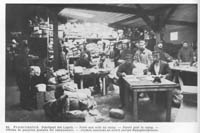 The American secretaries finished their tour at Ruhleben. They found the Association making good headway
among the British internees. The POWs had established a central committee representing all of the denominations in the camp, as well as
members from various camp committees (education, government, entertainment, and other organizations). The
participants approved a temporary constitution, and
The American secretaries finished their tour at Ruhleben. They found the Association making good headway
among the British internees. The POWs had established a central committee representing all of the denominations in the camp, as well as
members from various camp committees (education, government, entertainment, and other organizations). The
participants approved a temporary constitution, and
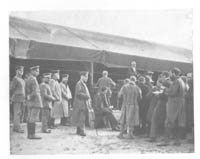 the groundbreaking for a YMCA hut was scheduled for the following week. The school at Ruhleben had grown
to 1,800 students and 150 teachers. Hoffman considered the ten thousand-man prisoner camp a wonderful opportunity
for Association work. After this tour, Hoffman decided to assign Sprunger to work in the XVIII Army Corps
district in camps under the command of the general staff at Frankfurt-am-Main.31
the groundbreaking for a YMCA hut was scheduled for the following week. The school at Ruhleben had grown
to 1,800 students and 150 teachers. Hoffman considered the ten thousand-man prisoner camp a wonderful opportunity
for Association work. After this tour, Hoffman decided to assign Sprunger to work in the XVIII Army Corps
district in camps under the command of the general staff at Frankfurt-am-Main.31
29
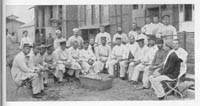 In addition to Hoffman and Sprunger, other American YMCA secretaries toured German prison camps during the
fall of 1915. Marshall M. Bartholomew visited the prison camp at Göttingen and was impressed by how quickly the
Association hut had become the center of social life. He reported that the library was constantly used,
and classes were well attended.
In addition to Hoffman and Sprunger, other American YMCA secretaries toured German prison camps during the
fall of 1915. Marshall M. Bartholomew visited the prison camp at Göttingen and was impressed by how quickly the
Association hut had become the center of social life. He reported that the library was constantly used,
and classes were well attended.
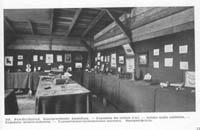 Prisoners enjoyed the music of a talented orchestra. Bartholomew also visited the publishing office, where
the camp newspaper was composed and printed. Bartholomew then toured the Allied officers' POW camp at
Hannoverisch-Münden, where the Germans had converted a large manufacturing building into the officers'
quarters. The POWs had a garden, tennis court, and an Association hall, constructed by the American YMCA.
After his visit, Bartholomew became a WPA Secretary working on behalf of Central Power POWs in Russia. His
observations of WPA work in Germany gave him the background necessary to establish similar welfare programs
in the spirit of reciprocity.32
Prisoners enjoyed the music of a talented orchestra. Bartholomew also visited the publishing office, where
the camp newspaper was composed and printed. Bartholomew then toured the Allied officers' POW camp at
Hannoverisch-Münden, where the Germans had converted a large manufacturing building into the officers'
quarters. The POWs had a garden, tennis court, and an Association hall, constructed by the American YMCA.
After his visit, Bartholomew became a WPA Secretary working on behalf of Central Power POWs in Russia. His
observations of WPA work in Germany gave him the background necessary to establish similar welfare programs
in the spirit of reciprocity.32
30
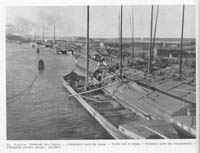 Other neutral countries also sent national YMCA secretaries to Germany relatively early in the war. Hermann
C. Rutgers, General Secretary of the Dutch Student Christian Movement, received permission from the Ministry
of War to visit Friedrichsfeld, a Prussian camp, in December 1915. Dutch Association members were sending parcels
to French prisoners at the camp and asked Rutgers to inspect conditions there. Rutgers was accompanied by Pastor
Charles Correvon, the minister
Other neutral countries also sent national YMCA secretaries to Germany relatively early in the war. Hermann
C. Rutgers, General Secretary of the Dutch Student Christian Movement, received permission from the Ministry
of War to visit Friedrichsfeld, a Prussian camp, in December 1915. Dutch Association members were sending parcels
to French prisoners at the camp and asked Rutgers to inspect conditions there. Rutgers was accompanied by Pastor
Charles Correvon, the minister
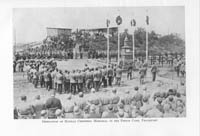 of the French Church in Frankfurt-am-Main. Correvon was born in Switzerland, but had become a naturalized German
subject, and held a general permit to visit all prison camps that contained French Protestants. The prison camp at
Friedrichsfeld held a total of thirty-five thousand prisoners (twenty thousand French POWs, twelve thousand Russians, and six hundred British prisoners).
Rutgers and Correvon
of the French Church in Frankfurt-am-Main. Correvon was born in Switzerland, but had become a naturalized German
subject, and held a general permit to visit all prison camps that contained French Protestants. The prison camp at
Friedrichsfeld held a total of thirty-five thousand prisoners (twenty thousand French POWs, twelve thousand Russians, and six hundred British prisoners).
Rutgers and Correvon
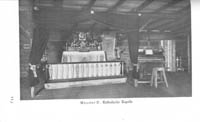 inspected the barracks, bathing facilities, barber shops, disinfecting plant, isolation camp, hospital, store
houses, post office, bank, school, and church. The latter was an empty barrack where the POWs could participate
in religious services. Seven Roman Catholic priests and one Protestant minister served the prison population.
The prisoners set up a philanthropic committee to supervise camp relief operations; the committee consisted of
one hundred men, representing all of the nationalities in the camp. They identified needy prisoners and
distributed relief parcels sent to the camp. Physical exercise was promoted, and boxing became especially
popular among the POWs.33
inspected the barracks, bathing facilities, barber shops, disinfecting plant, isolation camp, hospital, store
houses, post office, bank, school, and church. The latter was an empty barrack where the POWs could participate
in religious services. Seven Roman Catholic priests and one Protestant minister served the prison population.
The prisoners set up a philanthropic committee to supervise camp relief operations; the committee consisted of
one hundred men, representing all of the nationalities in the camp. They identified needy prisoners and
distributed relief parcels sent to the camp. Physical exercise was promoted, and boxing became especially
popular among the POWs.33
31
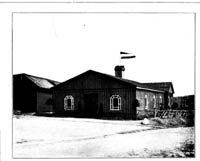 The school at Friedrichsfeld was quite developed. Classes ranged from basic reading for illiterates to foreign
languages (especially Flemish), drawing, painting, and stenography. Prisoners could also learn new skills,
including furniture- and doll-making, wood-carving, and postcard design. Most importantly, the Germans established
a rehabilitation center for wounded and disabled prisoners. Many of these men would not be able to return to their
pre-war trades, so they learned new trades such as tailoring, barbering, watch-making, bookkeeping, bookbinding,
printing, shoemaking, and cabinet-making. The rehabilitation center had twenty-one instructors, all POWs. The
commandant spent nine thousand Marks of camp funds to set up and equip this school. The idea of a rehabilitation center
was readily adopted by the American YMCA as an important component of the POW relief program. Rutgers freely
talked to the prisoners, and found that they had no complaints.
The school at Friedrichsfeld was quite developed. Classes ranged from basic reading for illiterates to foreign
languages (especially Flemish), drawing, painting, and stenography. Prisoners could also learn new skills,
including furniture- and doll-making, wood-carving, and postcard design. Most importantly, the Germans established
a rehabilitation center for wounded and disabled prisoners. Many of these men would not be able to return to their
pre-war trades, so they learned new trades such as tailoring, barbering, watch-making, bookkeeping, bookbinding,
printing, shoemaking, and cabinet-making. The rehabilitation center had twenty-one instructors, all POWs. The
commandant spent nine thousand Marks of camp funds to set up and equip this school. The idea of a rehabilitation center
was readily adopted by the American YMCA as an important component of the POW relief program. Rutgers freely
talked to the prisoners, and found that they had no complaints.
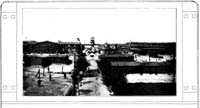 While the French wished to have more bread, the food was acceptable, although the POWs acknowledged they needed
parcels from home to avoid monotonous diets. In conclusion, Rutgers recognized that the POW relief effort would
be a major undertaking. From the perspective of the Dutch YMCA, relief work in Germany would be too daunting a
task. Secretaries were already committed to prisoner welfare work for British and Belgian soldiers interned in
the Netherlands, as well as relief work for Belgian civilians in refugee camps. In addition, the mobilization
of the Dutch Army, necessary to safeguard the kingdom's neutrality, required the Dutch Association to concentrate
its meager resources on social programs for the kingdom's soldiers.34
While the French wished to have more bread, the food was acceptable, although the POWs acknowledged they needed
parcels from home to avoid monotonous diets. In conclusion, Rutgers recognized that the POW relief effort would
be a major undertaking. From the perspective of the Dutch YMCA, relief work in Germany would be too daunting a
task. Secretaries were already committed to prisoner welfare work for British and Belgian soldiers interned in
the Netherlands, as well as relief work for Belgian civilians in refugee camps. In addition, the mobilization
of the Dutch Army, necessary to safeguard the kingdom's neutrality, required the Dutch Association to concentrate
its meager resources on social programs for the kingdom's soldiers.34
32 By October 1915, the YMCA had finished three huts in German prison camps at Göttingen, Crossen-an-der-Oder, and Hannoverisch-Münden, and three more were under construction in Danzig, Frankfurt-an-der-Oder, and Münster. The American YMCA also planned huts for Ruhleben, Dülmen, and in the VII Army Corps in Münster, where Pastor Schrenk was working. WPA work in Germany was well underway.35
33 On 29 May 1915, the Association hut in the camp at Crossen-an-der-Oder was completed. This camp, one of the largest in Germany, held mostly Russians, with a few French and British prisoners. Harte had ordered equipment for the facility in March, and the POWs provided the manpower for construction. This labor was important for the physical and mental welfare of the prisoners, since it filled their ample spare time. After the commandant inaugurated the building, the hut quickly became the social center of the compound. On the first day of operations, the library lent out 130 books; on the second day, three hundred books were borrowed; and on the third day, the POWs took out 450 books. For illiterate prisoners, the YMCA education committee organized circles where books were read aloud. This committee also set up an extensive education system, offering classes for elementary to advanced students. In addition, the YMCA religion committee organized divine services for all the faiths represented at Crossen.36
34
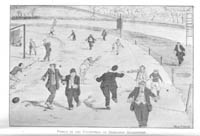 After opening an Association hut at Göttingen, Red Triangle work also mushroomed. The American YMCA provided
musical instruments and lessons, and the POWs formed an international orchestra (called "The European Concert"),
a mandolin club, a camp choir for French and Belgian singers, and an English choir. With the stage in the
Association hut and costumes and
After opening an Association hut at Göttingen, Red Triangle work also mushroomed. The American YMCA provided
musical instruments and lessons, and the POWs formed an international orchestra (called "The European Concert"),
a mandolin club, a camp choir for French and Belgian singers, and an English choir. With the stage in the
Association hut and costumes and
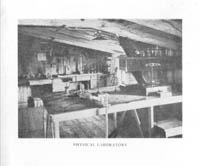 props provided by the YMCA, the French prisoners formed a theatrical company called the "Sun's Rays," while
Flemish, Walloon, and British players formed their own troupes. Three camp newspapers were printed, in English
and French editions.
The YMCA education committee offered classes and lectures in fifteen different subjects. The reading room of
the library held over four thousand volumes. The Association's religious committee conducted religious services in the
props provided by the YMCA, the French prisoners formed a theatrical company called the "Sun's Rays," while
Flemish, Walloon, and British players formed their own troupes. Three camp newspapers were printed, in English
and French editions.
The YMCA education committee offered classes and lectures in fifteen different subjects. The reading room of
the library held over four thousand volumes. The Association's religious committee conducted religious services in the
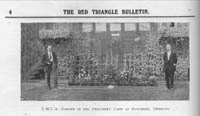 Red Triangle hut for Protestants, Roman Catholics, Russian Orthodox, and Jews. The commandant was so impressed
with the YMCA program that he gave three additional barracks to the Association committee. Ambassador Gerard
credited the YMCA with saving the sanity of a large number of POWs at Göttingen, especially as the war
dragged on without end.37
Red Triangle hut for Protestants, Roman Catholics, Russian Orthodox, and Jews. The commandant was so impressed
with the YMCA program that he gave three additional barracks to the Association committee. Ambassador Gerard
credited the YMCA with saving the sanity of a large number of POWs at Göttingen, especially as the war
dragged on without end.37
Development of Association Work at Ruhleben
35
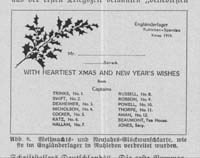 Despite the good start at Ruhleben, Hoffman urged the American YMCA to expand operations as soon as possible.
After his first visit in October 1915, he recognized the urgent need to augment the existing programs and
introduce new facilities to house the activities. Early in the war, the internees had organized several
theatrical clubs, musical organizations, schools, religious organizations, and handicraft departments for
congenial companionship and profitable occupation. But, despite these activities, approximately one hundred
men in the camp went insane during the conflict. The early part of the war was the most miserable time for most men.
The Germans attempted to impose military discipline on the English civilians, which provoked a hostile protest
by the POWs. Eventually, the German authorities granted the internees self-government
Despite the good start at Ruhleben, Hoffman urged the American YMCA to expand operations as soon as possible.
After his first visit in October 1915, he recognized the urgent need to augment the existing programs and
introduce new facilities to house the activities. Early in the war, the internees had organized several
theatrical clubs, musical organizations, schools, religious organizations, and handicraft departments for
congenial companionship and profitable occupation. But, despite these activities, approximately one hundred
men in the camp went insane during the conflict. The early part of the war was the most miserable time for most men.
The Germans attempted to impose military discipline on the English civilians, which provoked a hostile protest
by the POWs. Eventually, the German authorities granted the internees self-government
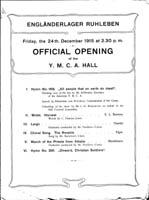 inside the camp: each barrack selected a representative, or captain, and these captains elected a president,
who dealt directly with the commandant. As the prisoners realized that the war would be a prolonged affair,
they converted the camp into a "town." Along Bond Street, prisoners could purchase a variety of goods such
as cooking utensils, toilet articles, clothing, books, and services (shoemaker and tailor shops). The pro-German
element ("Deutsch gesinnt") in the camp (mostly German-born British subjects) lived in the "tea house," and
were ostracized by the loyal Britishers in the camp. Hoffman determined that the prisoners at Ruhleben needed
a library, reading room, additional classrooms, adequate quarters for church services, and a hall for social
entertainment.38
inside the camp: each barrack selected a representative, or captain, and these captains elected a president,
who dealt directly with the commandant. As the prisoners realized that the war would be a prolonged affair,
they converted the camp into a "town." Along Bond Street, prisoners could purchase a variety of goods such
as cooking utensils, toilet articles, clothing, books, and services (shoemaker and tailor shops). The pro-German
element ("Deutsch gesinnt") in the camp (mostly German-born British subjects) lived in the "tea house," and
were ostracized by the loyal Britishers in the camp. Hoffman determined that the prisoners at Ruhleben needed
a library, reading room, additional classrooms, adequate quarters for church services, and a hall for social
entertainment.38
36
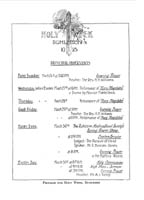 Hoffman expanded Association activities quickly once he began WPA operations. Ambassador Gerard arranged for
internees to use the athletic field inside the race-track, and the YMCA provided sports equipment. Whenever
weather permitted, internees played tennis, field hockey, soccer, golf, cricket, or baseball (there were many
Canadians in the camp); Spaulding and Company generously contributed a complete baseball outfit. During the
winter of 1916-1917, the internees flooded the infield and it became an excellent skating rink. Another important
feature of the prison camp was the "Grand Stand University." The POWs set up classes under the grandstand of the
race-track for which students could earn college credit. The American YMCA expanded the range of classes and
lectures, including study circles for more intensive study, including French, Spanish, Gaelic, Technical,
Sociological, and Woolen and Worsted Circles. The YMCA also provided equipment to augment the physical, chemical,
electrical, and biological laboratories. During the winter of 1915, they supported classes in French, Spanish,
art, commerce, science, mathematics, engineering, nautical science, and handicrafts. By the summer of 1917, the
curriculum included English, German, Celtic, Italian, Russian, Dutch, Danish, physical science, biology,
engineering, and music. The YMCA also negotiated with the Royal Library of Berlin to borrow books required by
Ruhleben prisoners who wanted to conduct advanced research. The Association also sponsored a series of academic
and hobby exhibitions and contests, such as that held in April 1916, when the "Tercentenary Shakespeare Festival"
took place, as well as a horticultural and garden show during Easter 1917. In addition, the YMCA held various
handicraft exhibitions, including shows of model boats, leather-work, and silver-smith work. Many of the products
were sold in Sweden through the offices of Crown Princess Margaret to provide the POWs with additional
income.39
Hoffman expanded Association activities quickly once he began WPA operations. Ambassador Gerard arranged for
internees to use the athletic field inside the race-track, and the YMCA provided sports equipment. Whenever
weather permitted, internees played tennis, field hockey, soccer, golf, cricket, or baseball (there were many
Canadians in the camp); Spaulding and Company generously contributed a complete baseball outfit. During the
winter of 1916-1917, the internees flooded the infield and it became an excellent skating rink. Another important
feature of the prison camp was the "Grand Stand University." The POWs set up classes under the grandstand of the
race-track for which students could earn college credit. The American YMCA expanded the range of classes and
lectures, including study circles for more intensive study, including French, Spanish, Gaelic, Technical,
Sociological, and Woolen and Worsted Circles. The YMCA also provided equipment to augment the physical, chemical,
electrical, and biological laboratories. During the winter of 1915, they supported classes in French, Spanish,
art, commerce, science, mathematics, engineering, nautical science, and handicrafts. By the summer of 1917, the
curriculum included English, German, Celtic, Italian, Russian, Dutch, Danish, physical science, biology,
engineering, and music. The YMCA also negotiated with the Royal Library of Berlin to borrow books required by
Ruhleben prisoners who wanted to conduct advanced research. The Association also sponsored a series of academic
and hobby exhibitions and contests, such as that held in April 1916, when the "Tercentenary Shakespeare Festival"
took place, as well as a horticultural and garden show during Easter 1917. In addition, the YMCA held various
handicraft exhibitions, including shows of model boats, leather-work, and silver-smith work. Many of the products
were sold in Sweden through the offices of Crown Princess Margaret to provide the POWs with additional
income.39
37
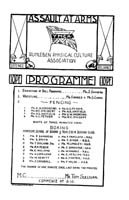 The American secretary took immediate steps in October 1915 to speed up the construction of the YMCA hut in
Ruhleben. Despite official construction permits, the German authorities were slow to act on the project. But
once Hoffman engaged a contractor for building material, work on the hut began in November. The POWs worked hard,
and the facility was ready for its dedication on December 24. The building was presented to the POWs as a Christmas
gift from the American YMCA and the Student Friendship League. The prisoners decorated the hall with evergreen
branches, and the commandant donated two immense Christmas trees. The POWs did not set up chairs, so that they
could crowd in as many men as possible. Over one thousand prisoners participated in the dedication, and many more
listened in through open windows and doors. On Christmas Day, this hall was the site of five different church
services. The building became the center of a wide range of camp activities, including regular church services, a
reference library, school rooms, art studio, the Italian seminary, and a club room. In addition, social
entertainment, Bible study classes, and physical education activities were conducted in the YMCA hall.40
The American secretary took immediate steps in October 1915 to speed up the construction of the YMCA hut in
Ruhleben. Despite official construction permits, the German authorities were slow to act on the project. But
once Hoffman engaged a contractor for building material, work on the hut began in November. The POWs worked hard,
and the facility was ready for its dedication on December 24. The building was presented to the POWs as a Christmas
gift from the American YMCA and the Student Friendship League. The prisoners decorated the hall with evergreen
branches, and the commandant donated two immense Christmas trees. The POWs did not set up chairs, so that they
could crowd in as many men as possible. Over one thousand prisoners participated in the dedication, and many more
listened in through open windows and doors. On Christmas Day, this hall was the site of five different church
services. The building became the center of a wide range of camp activities, including regular church services, a
reference library, school rooms, art studio, the Italian seminary, and a club room. In addition, social
entertainment, Bible study classes, and physical education activities were conducted in the YMCA hall.40
38
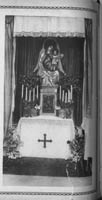 An important part of Association work was spiritual relief, and Sprunger took the lead in conducting evangelism
campaigns at Ruhleben. The POWs organized a special YMCA Religious Committee to assume responsibility for the
spiritual improvement of the camp. They initially worked with Reverend H. M. Williams, Chaplain of Berlin, who
ministered to British POWs in Germany. Then three inmates suggested an evangelistic campaign for the prison as
the best means to boost Association enrollment. Although the idea was met with skepticism, the POWs organized a
committee of sixty men to prepare the campaign. Sprunger supervised the "Association Week" campaign, which lasted
from 2-6 February 1916. To publicize the event, Hoffman led prayer meetings, each POW received a personal invitation
card, and workers volunteered to promote the event in every barrack. The YMCA printed posters for the campaign and
the meeting became the talk of the camp.
An important part of Association work was spiritual relief, and Sprunger took the lead in conducting evangelism
campaigns at Ruhleben. The POWs organized a special YMCA Religious Committee to assume responsibility for the
spiritual improvement of the camp. They initially worked with Reverend H. M. Williams, Chaplain of Berlin, who
ministered to British POWs in Germany. Then three inmates suggested an evangelistic campaign for the prison as
the best means to boost Association enrollment. Although the idea was met with skepticism, the POWs organized a
committee of sixty men to prepare the campaign. Sprunger supervised the "Association Week" campaign, which lasted
from 2-6 February 1916. To publicize the event, Hoffman led prayer meetings, each POW received a personal invitation
card, and workers volunteered to promote the event in every barrack. The YMCA printed posters for the campaign and
the meeting became the talk of the camp.
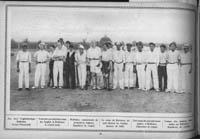 The "Association Week" activities began with Sprunger's opening address.
The hall was packed with men singing songs. On the second night, Hoffman gave an account of his life story to an
audience that came to see lantern slides. Sprunger spoke on the last three nights, and morning cards were
distributed at the Saturday meeting. The American secretaries used a revival-meeting approach, and called for open
decisions on the part of the POWs. On the last evening of the campaign, three hundred men arose and filled out their decision
cards, indicating their choice to accept Christ into their daily lives. This event marked the first evangelical
campaign conducted by the American YMCA in a POW camp.41
The "Association Week" activities began with Sprunger's opening address.
The hall was packed with men singing songs. On the second night, Hoffman gave an account of his life story to an
audience that came to see lantern slides. Sprunger spoke on the last three nights, and morning cards were
distributed at the Saturday meeting. The American secretaries used a revival-meeting approach, and called for open
decisions on the part of the POWs. On the last evening of the campaign, three hundred men arose and filled out their decision
cards, indicating their choice to accept Christ into their daily lives. This event marked the first evangelical
campaign conducted by the American YMCA in a POW camp.41
39 As a result of this successful evangelism campaign, Hoffman returned to Ruhleben on February 9 to organize the Association in the camp on a definitive basis. During a preliminary discussion, the secretary explained the conditions for membership, and the assembled group decided to charge a fifty Pfennig membership fee and a ten Pfennig monthly fee. Despite the fees, 157 men enrolled immediately as charter members of the Ruhleben YMCA. The new Association members then elected a board of directors (the president was a Student Christian Volunteer from Australia), and the YMCA was officially established at Ruhleben.42
40
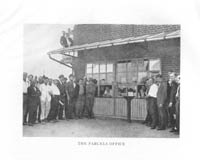 During the remainder of the war, the Association held two three-day YMCA religious conferences at Ruhleben.
These were held in the Association hall to consolidate YMCA work in the camp and to obtain a corporate feeling
of responsibility in meeting the problems of prison camp life. The meetings were open to Association members
after the payment of a four-cent registration fee.
During the remainder of the war, the Association held two three-day YMCA religious conferences at Ruhleben.
These were held in the Association hall to consolidate YMCA work in the camp and to obtain a corporate feeling
of responsibility in meeting the problems of prison camp life. The meetings were open to Association members
after the payment of a four-cent registration fee.
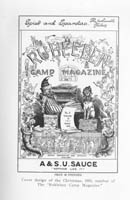 Average attendance was ninety-eight men. Each session was divided into three parts: the first consisted of a combined devotional meeting, which followed the lines of the weekly Sunday
evening Association prayer meeting; the second focused on study and discussion circles; and the last part included
an address. There were three types of circles.
Average attendance was ninety-eight men. Each session was divided into three parts: the first consisted of a combined devotional meeting, which followed the lines of the weekly Sunday
evening Association prayer meeting; the second focused on study and discussion circles; and the last part included
an address. There were three types of circles.
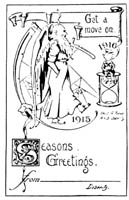 A beginners' circle included men who had never attended any Association study courses, and they investigated a
wide range of topics, including the life and personality of Christ.
An intermediate circle, consisting of men who had read the Gospels in conjunction with an Association program, continued their studies of the life of
Christ and considered their own personal relationship to mankind. A special circle of older men met to consider
the problems and the function of the YMCA in the prison camp. At the end of each day's session, an Association
secretary gave a devotional address dealing with the value and interrelationship of Bible study, personal work,
and prayer.
By focusing on religious issues, the YMCA strove to improve the spiritual side of life in Ruhleben.43
A beginners' circle included men who had never attended any Association study courses, and they investigated a
wide range of topics, including the life and personality of Christ.
An intermediate circle, consisting of men who had read the Gospels in conjunction with an Association program, continued their studies of the life of
Christ and considered their own personal relationship to mankind. A special circle of older men met to consider
the problems and the function of the YMCA in the prison camp. At the end of each day's session, an Association
secretary gave a devotional address dealing with the value and interrelationship of Bible study, personal work,
and prayer.
By focusing on religious issues, the YMCA strove to improve the spiritual side of life in Ruhleben.43
41
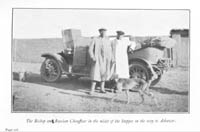 Conditions at Ruhleben continued to be a serious problem and were reported negatively in the British press throughout
the war. To assess the situation in the camp, Bishop Herbert Bury, Anglican Bishop for Northern and Central
Europe, applied through the Bürgermeister of Munich to visit the facility in August 1916. Bury was in a
unique position to conduct POW investigations. He had considerable influence in Central Europe (as well as in Britain),
due to his pre-war position in the Anglican Church, and he made the care and treatment of war prisoners a personal
concern.
Conditions at Ruhleben continued to be a serious problem and were reported negatively in the British press throughout
the war. To assess the situation in the camp, Bishop Herbert Bury, Anglican Bishop for Northern and Central
Europe, applied through the Bürgermeister of Munich to visit the facility in August 1916. Bury was in a
unique position to conduct POW investigations. He had considerable influence in Central Europe (as well as in Britain),
due to his pre-war position in the Anglican Church, and he made the care and treatment of war prisoners a personal
concern.
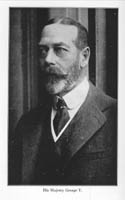 The German government extended an official invitation for the bishop to visit Ruhleben, and he toured the camp between November 22-29.
He was free to move about the facility and spend as much time as he wished with the
prisoners, since German authorities wanted to prove that conditions were not as bad as commonly reported in the
English press (the London Daily Mail covered the visit). Bury praised the POWs for not wasting their time
moping. With the assistance of the YMCA, they had a theater, concerts, debating society, well-organized schools,
soccer, and the Association hut to keep them busy and interested. These activities were their greatest ally in their
fight to keep up their spirits.
The German government extended an official invitation for the bishop to visit Ruhleben, and he toured the camp between November 22-29.
He was free to move about the facility and spend as much time as he wished with the
prisoners, since German authorities wanted to prove that conditions were not as bad as commonly reported in the
English press (the London Daily Mail covered the visit). Bury praised the POWs for not wasting their time
moping. With the assistance of the YMCA, they had a theater, concerts, debating society, well-organized schools,
soccer, and the Association hut to keep them busy and interested. These activities were their greatest ally in their
fight to keep up their spirits.
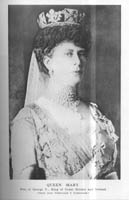 But Bury also observed that two years of strain were beginning to tell on even the
strongest of prisoners.
While the younger men stood up better, nervous pressure had broken many of the middle-aged and older prisoners. The Germans had recently adopted the policy of allowing internees to meet their families, whom
they had not seen since the beginning of the war, in special barracks-in Germany-but for only fifteen minutes per
month, in the presence of German guards. Despite these problems, Bury observed that their toughest fight was against
the collapse of mind and spirit, and concluded the POWs were doing well. The bishop returned to England and reported
to King George V and Queen Mary at Windsor Castle.44
But Bury also observed that two years of strain were beginning to tell on even the
strongest of prisoners.
While the younger men stood up better, nervous pressure had broken many of the middle-aged and older prisoners. The Germans had recently adopted the policy of allowing internees to meet their families, whom
they had not seen since the beginning of the war, in special barracks-in Germany-but for only fifteen minutes per
month, in the presence of German guards. Despite these problems, Bury observed that their toughest fight was against
the collapse of mind and spirit, and concluded the POWs were doing well. The bishop returned to England and reported
to King George V and Queen Mary at Windsor Castle.44
42 As the war dragged on and the Allied blockade reduced food supplies in Germany, POWs shifted their attention from spiritual and mental relief to physical survival. The Germans severely reduced food rations to civilian internees at Ruhleben, eventually eliminating meat and cutting back on potatoes by the summer of 1916. The caloric content of daily rations fell below the subsistence level. Despite this deficiency, British internees were never in serious danger of starvation. Because of food parcels from family, friends, and English relief agencies, they were in the enviable position of receiving a diet superior to civilians in German cities. The POWs in Ruhleben organized relief operations, such as collecting woolen socks for needy Serbian POWs in other camps. When Hoffman began arriving at the prison not appearing well, the prisoners became concerned about his welfare and regularly presented the American secretary with a box of supplies before he left. Ruhleben remained a top priority for the American YMCA during the war, and Hoffman constantly sought to coordinate and expand services in the camp.45
Initial Expansion of American YMCA Operations across Germany
43
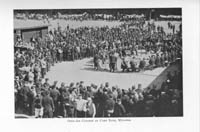 By December 1915, the American YMCA had WPA operations well underway in Germany. Hoffman and Sprunger strove
to make Christmas as joyous an occasion as possible for as many POWs as they could reach. The Yuletide was
the most difficult time of the year for most prisoners, since they longed to be home with their loved ones.
As a result, the Association made every effort to instill joy into the season and bolster the POWs' spirits.
The American Senior Secretary visited prisoners in military hospitals in the Berlin area. At one camp, he
received permission to bring musicians, a chorus, and other entertainers from the main prison compound to
visit their comrades in the hospital. Hoffman arranged for three Christmas
By December 1915, the American YMCA had WPA operations well underway in Germany. Hoffman and Sprunger strove
to make Christmas as joyous an occasion as possible for as many POWs as they could reach. The Yuletide was
the most difficult time of the year for most prisoners, since they longed to be home with their loved ones.
As a result, the Association made every effort to instill joy into the season and bolster the POWs' spirits.
The American Senior Secretary visited prisoners in military hospitals in the Berlin area. At one camp, he
received permission to bring musicians, a chorus, and other entertainers from the main prison compound to
visit their comrades in the hospital. Hoffman arranged for three Christmas
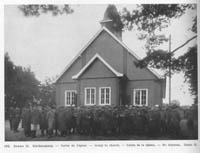 trees to be set up and decorated with candles and ornaments. A table was set up, and each place contained an
orange, an apple, six cigarettes, chocolate cake, and two pieces of Lebkuchen (gingerbread). The American
secretary and the YMCA president visited nine men who were too sick to be moved from their beds. Entertainment
included a short program by a chorus of eight English POWs. Hoffman made a brief Christmas address, and the
Chief Surgeon said a few words, wishing all of the men a merry Christmas, and hoping that everyone would be
spending their next yuletide at home. Hoffman returned to the main prison, where the prisoners had decorated
the YMCA reading room for Christmas Day, expressing season's greetings in French,
trees to be set up and decorated with candles and ornaments. A table was set up, and each place contained an
orange, an apple, six cigarettes, chocolate cake, and two pieces of Lebkuchen (gingerbread). The American
secretary and the YMCA president visited nine men who were too sick to be moved from their beds. Entertainment
included a short program by a chorus of eight English POWs. Hoffman made a brief Christmas address, and the
Chief Surgeon said a few words, wishing all of the men a merry Christmas, and hoping that everyone would be
spending their next yuletide at home. Hoffman returned to the main prison, where the prisoners had decorated
the YMCA reading room for Christmas Day, expressing season's greetings in French,
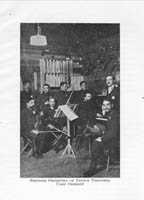 Russian, Flemish, Polish, German, and English. Hoffman gave the Welfare Committee in the camp two hundred Marks so
they could purchase apples and cakes for the Russian prisoners, who would not be receiving any Christmas
presents from home. That evening, the prisoners enjoyed an elaborate program of orchestral, vocal, and
instrumental music, plus comic opera, with hot chocolate served during the intermission. The Senior American
Secretary spoke with a German guard who was upset that he was away from his family for Christmas. Hoffman
realized that there were hundreds of thousands of similar men-and millions of mothers, wives, and
children-spending an equally lonely Christmas at home. But as Hoffman left the camp, he was glad that he had
been able to spread some Christmas cheer.46
Russian, Flemish, Polish, German, and English. Hoffman gave the Welfare Committee in the camp two hundred Marks so
they could purchase apples and cakes for the Russian prisoners, who would not be receiving any Christmas
presents from home. That evening, the prisoners enjoyed an elaborate program of orchestral, vocal, and
instrumental music, plus comic opera, with hot chocolate served during the intermission. The Senior American
Secretary spoke with a German guard who was upset that he was away from his family for Christmas. Hoffman
realized that there were hundreds of thousands of similar men-and millions of mothers, wives, and
children-spending an equally lonely Christmas at home. But as Hoffman left the camp, he was glad that he had
been able to spread some Christmas cheer.46
44
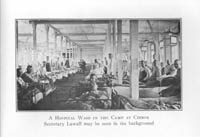 At the end of 1915, the American YMCA still had only two American secretaries working in Germany.
At the end of 1915, the American YMCA still had only two American secretaries working in Germany.
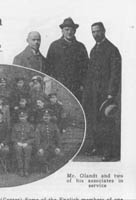 Two new Red Triangle workers, however-William H. Lawall and the Reverend Claus Olandt-had arrived just before Christmas
(December 1 and December 15, respectively) and were awaiting their camp visitation permits. Hoffman assigned Lawall to work with the
Russian prisoners, even though he did not speak their language and would have to work through an interpreter.
German officials were eager to render the YMCA every possible assistance in expanding the WPA program.47
Two new Red Triangle workers, however-William H. Lawall and the Reverend Claus Olandt-had arrived just before Christmas
(December 1 and December 15, respectively) and were awaiting their camp visitation permits. Hoffman assigned Lawall to work with the
Russian prisoners, even though he did not speak their language and would have to work through an interpreter.
German officials were eager to render the YMCA every possible assistance in expanding the WPA program.47
45 By January 1916, the American YMCA had constructed seven additional Association huts: one at Danzig for Russian POWs; at Frankfurt-an-der-Oder for Russian enlisted prisoners, at Münster I, primarily for French POWs; at Sennelager for Allied enlisted prisoners; at Dülmen for Allied enlisted POWs; at Ohrdruf (Thuringia), primarily for French enlisted POWs; and at Darmstadt for French enlisted POWs. The American YMCA planned to construct additional huts in four or five prison camps in the immediate future. According to Hoffman, the Germans held over 1.5 million Allied POWs at this time (twenty-five thousand British POWs, 250,000 French prisoners, and the remainder primarily Russians). Due to the large number of prisoners in German custody, the YMCA faced practically no restrictions in Germany, and found that "the door of opportunity and helpfulness on behalf of these POWs was wide open." Providing services to British prisoners was easily accomplished, but Hoffman requested more secretaries who could speak Russian and French to provide more comprehensive service.48
46
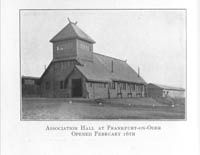 The Association hall at Frankfurt-an-der-Oder officially opened on 15 February 1916. Despite the usual German
practice of integrating Allied prisoners, all of the POWs at Frankfurt-an-der-Oder were Russian. The YMCA had
established ties with the prison camp in July 1915, when the prison camp cemetery was officially opened. To
introduce the YMCA, an American secretary held a lantern-slide show that described Association work.
The Russian POWs were interested in the YMCA, and organized a Christian Soldiers' Association to begin work.
The Association hall at Frankfurt-an-der-Oder officially opened on 15 February 1916. Despite the usual German
practice of integrating Allied prisoners, all of the POWs at Frankfurt-an-der-Oder were Russian. The YMCA had
established ties with the prison camp in July 1915, when the prison camp cemetery was officially opened. To
introduce the YMCA, an American secretary held a lantern-slide show that described Association work.
The Russian POWs were interested in the YMCA, and organized a Christian Soldiers' Association to begin work.
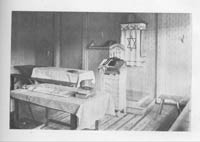 The secretary
was soon besieged with requests from the camp to promote religious services, schoolwork, and athletic contests.
The camp at Frankfurt-an-der-Oder was clearly an ideal location for an Association hall. The building copied Norwegian architecture and featured an interior hand-carved by Russian POWs. The furnishings were equally ornate,
especially the benches and candelabras, also produced by the prisoners.
The altar featured a semi-circular picture
of Da Vinci's "Last Supper" found rolled up inside iron sheeting in a Russian town. The hall cost the American YMCA
over six thousand Marks to construct, while the camp commandant and local civic groups raised an additional thirty thousand Marks
to purchase equipment, furniture, and supplies to get the organization underway. The bells in the Association hall's
belfry, which called the POWs to religious services, came from Warsaw.49
The secretary
was soon besieged with requests from the camp to promote religious services, schoolwork, and athletic contests.
The camp at Frankfurt-an-der-Oder was clearly an ideal location for an Association hall. The building copied Norwegian architecture and featured an interior hand-carved by Russian POWs. The furnishings were equally ornate,
especially the benches and candelabras, also produced by the prisoners.
The altar featured a semi-circular picture
of Da Vinci's "Last Supper" found rolled up inside iron sheeting in a Russian town. The hall cost the American YMCA
over six thousand Marks to construct, while the camp commandant and local civic groups raised an additional thirty thousand Marks
to purchase equipment, furniture, and supplies to get the organization underway. The bells in the Association hall's
belfry, which called the POWs to religious services, came from Warsaw.49
47
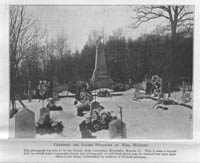 At Münster I, the YMCA hut became the center of social activities for the French and the small number of British
prisoners. Before the construction of the hall, POWs had limited access to religious services. Catholic prisoners
occasionally attended a local church, while British prisoners had visited a Union Church (Methodist) only three times.
The clergyman spoke some English, and the camp commandant agreed to permit the minister to conduct services in the new
YMCA hut. In addition, Hoffman worked with a French prisoner, G. A. Champion, who had planned to enter the priesthood
before the war. He undertook religious work among the French POWs, and upon due reflection decided that YMCA work brought
him
At Münster I, the YMCA hut became the center of social activities for the French and the small number of British
prisoners. Before the construction of the hall, POWs had limited access to religious services. Catholic prisoners
occasionally attended a local church, while British prisoners had visited a Union Church (Methodist) only three times.
The clergyman spoke some English, and the camp commandant agreed to permit the minister to conduct services in the new
YMCA hut. In addition, Hoffman worked with a French prisoner, G. A. Champion, who had planned to enter the priesthood
before the war. He undertook religious work among the French POWs, and upon due reflection decided that YMCA work brought
him
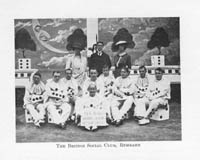 greater satisfaction. He found life as a priest rewarding, but found himself "inclined that such a life would not be
energetic enough for me… What of the Young Men's Christian Association?" The prisoners at Münster obtained
a piano and several musical instruments and formed a small orchestra. In addition, the POWs had access to an exercise
yard, but looked forward to playing soccer once the harvest was completed in the fall. The YMCA, prisoners, and German
authorities also worked together on a monument in the cemetery in memory of the French POWs who had died at Münster.
The prisoners designed the monument, which they built with the assistance of the Germans and the YMCA.50
greater satisfaction. He found life as a priest rewarding, but found himself "inclined that such a life would not be
energetic enough for me… What of the Young Men's Christian Association?" The prisoners at Münster obtained
a piano and several musical instruments and formed a small orchestra. In addition, the POWs had access to an exercise
yard, but looked forward to playing soccer once the harvest was completed in the fall. The YMCA, prisoners, and German
authorities also worked together on a monument in the cemetery in memory of the French POWs who had died at Münster.
The prisoners designed the monument, which they built with the assistance of the Germans and the YMCA.50
48
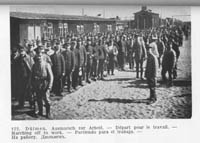 Olandt organized and expanded the Association WPA program at Dülmen. This prison camp was one of the largest
in Germany and contained British, French, Belgian, Indian, and other Allied prisoners. Although the YMCA hall was
completed early in 1916, the official inauguration was not held until May 7. Olandt immediately set to work setting up a school system,
a library, and religious services. He also led a series of evangelistic meetings in nearby prison camps. Because of
the large number of British POWs in that district, Olandt felt that he had a wonderful opportunity to meet prisoners'
needs and render a valuable service.
51
Olandt organized and expanded the Association WPA program at Dülmen. This prison camp was one of the largest
in Germany and contained British, French, Belgian, Indian, and other Allied prisoners. Although the YMCA hall was
completed early in 1916, the official inauguration was not held until May 7. Olandt immediately set to work setting up a school system,
a library, and religious services. He also led a series of evangelistic meetings in nearby prison camps. Because of
the large number of British POWs in that district, Olandt felt that he had a wonderful opportunity to meet prisoners'
needs and render a valuable service.
51
49
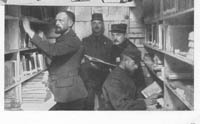 The Stammlager at Ohrdruf held over twelve thousand prisoners, mostly French. Approximately five thousand prisoners worked
outside the main camp during the day in the spring of 1916, leaving seven thousand men idle in the compound. More than three thousand
of these POWs were wounded, with a great deal of time on their hands. An additional 1,600 prisoners languished in a
local military hospital. Sprunger recommended the construction of an Association hall for the camp, and was readily
supported by Hoffman.
The Stammlager at Ohrdruf held over twelve thousand prisoners, mostly French. Approximately five thousand prisoners worked
outside the main camp during the day in the spring of 1916, leaving seven thousand men idle in the compound. More than three thousand
of these POWs were wounded, with a great deal of time on their hands. An additional 1,600 prisoners languished in a
local military hospital. Sprunger recommended the construction of an Association hall for the camp, and was readily
supported by Hoffman.
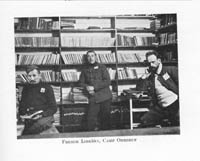 After consulting the camp's YMCA committee, Sprunger and the prisoners chose to build a twenty-five thousand Mark building.
The American YMCA agreed to provide $2,000 for its construction, and the remainder was collected through canteen
sales to the POWs. One of the first priorities was the establishment of an education program. In the POW hospital
alone, one thousand prisoners immediately signed up for classes.52
After consulting the camp's YMCA committee, Sprunger and the prisoners chose to build a twenty-five thousand Mark building.
The American YMCA agreed to provide $2,000 for its construction, and the remainder was collected through canteen
sales to the POWs. One of the first priorities was the establishment of an education program. In the POW hospital
alone, one thousand prisoners immediately signed up for classes.52
50
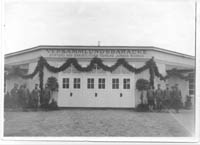 The American YMCA also constructed an Association hall at Darmstadt by the end of 1915. The prison camp was
situated in the beautiful rolling countryside of the Taunus Mountains. The official opening was delayed until
28 May 1916, but was attended by an impressive gallery of dignitaries. Prince Max of
The American YMCA also constructed an Association hall at Darmstadt by the end of 1915. The prison camp was
situated in the beautiful rolling countryside of the Taunus Mountains. The official opening was delayed until
28 May 1916, but was attended by an impressive gallery of dignitaries. Prince Max of
 Baden and Mr. Harris, the U.S. Consul in Frankfurt-am-Main, attended the inauguration. Professor Thomas C. Hall represented the American YMCA and gave the opening address.
The American seminarian echoed the Christian International theme promoted by the YMCA in his speech:
Baden and Mr. Harris, the U.S. Consul in Frankfurt-am-Main, attended the inauguration. Professor Thomas C. Hall represented the American YMCA and gave the opening address.
The American seminarian echoed the Christian International theme promoted by the YMCA in his speech:
More terrible than the devastation of town and country would be a lasting hate sown among the fighting nations. Peace must come some time, and it is to be hoped that this building may do something to further mutual understandings between the warring nations, so that when the peace comes it may have a firm foundation of mutual respect. We are all human beings and must live together somehow, nor is it impossible even in the bitterest warfare to remember to be chivalrous and to cultivate nobility of mind.53
Hall presented the keys to the building to the camp commandant in the name of the German YMCA, the DCSV, and the International Committee of the American YMCA.54
51
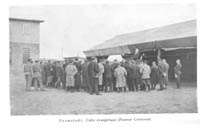 The Association received a great deal of support for WPA work at Darmstadt. Sprunger found the general in command
of the XVIII Army Corps, who was stationed at Frankfurt-am-Main, an enthusiastic supporter of the YMCA POW relief
program, as well as his commandants, who never refused one of Sprunger's requests. Professors from the University
of Darmstadt readily volunteered to teach classes. Pastor Correvon and a Roman Catholic priest in Darmstadt took
an active interest in WPA operations. In addition, Harris and his wife extended their assistance in promoting POW
relief whenever possible. Prisoners were also eager to support the Association program.
The Association received a great deal of support for WPA work at Darmstadt. Sprunger found the general in command
of the XVIII Army Corps, who was stationed at Frankfurt-am-Main, an enthusiastic supporter of the YMCA POW relief
program, as well as his commandants, who never refused one of Sprunger's requests. Professors from the University
of Darmstadt readily volunteered to teach classes. Pastor Correvon and a Roman Catholic priest in Darmstadt took
an active interest in WPA operations. In addition, Harris and his wife extended their assistance in promoting POW
relief whenever possible. Prisoners were also eager to support the Association program.
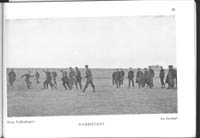 A French POW who had been
a missionary in the Zambesi region of East Africa assisted Sprunger. After Sprunger had to leave Germany because
he had contracted influenza, he was replaced by Carl Michel in February 1916. Michel found the Association hut at
Darmstadt one of the most attractive and practical POW barracks in Germany. As planned, the Association hall became
the center of recreation, intellectual inspiration, and spiritual relief for the entire camp. A variety of religious
services were held in the hall to provide comfort to the prisoners. The library distributed a wide range of reading
matter, as well as a space where POWs could study and strive for mental improvement. The prison camp school catered
to a wide range of students. The American YMCA financed an illustrated lecture course to help illiterates learn to
read, while advanced students could take advantage of extending their university educations. The Association hut
made life in the camp brighter and more social.55
A French POW who had been
a missionary in the Zambesi region of East Africa assisted Sprunger. After Sprunger had to leave Germany because
he had contracted influenza, he was replaced by Carl Michel in February 1916. Michel found the Association hut at
Darmstadt one of the most attractive and practical POW barracks in Germany. As planned, the Association hall became
the center of recreation, intellectual inspiration, and spiritual relief for the entire camp. A variety of religious
services were held in the hall to provide comfort to the prisoners. The library distributed a wide range of reading
matter, as well as a space where POWs could study and strive for mental improvement. The prison camp school catered
to a wide range of students. The American YMCA financed an illustrated lecture course to help illiterates learn to
read, while advanced students could take advantage of extending their university educations. The Association hut
made life in the camp brighter and more social.55
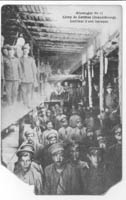 The American YMCA also paid for the construction and maintenance of an Association hall at Cottbus in Brandenburg
under the control of the III Army Corps in July 1916. Hoffman assigned J. Gustav White, an American secretary who
had arrived in April, to organize a prison camp Association at Cottbus, and he worked well with the commandant,
General Kretzschmer. A German sergeant supervised the planning and construction of the building, while another
non-commissioned officer took responsibility for painting and decorating the hall. Two French prisoners constructed
the facility while members of the Landsturm and POWs helped with wood-carving, knitting, masonry work, and
carpentry. The city of Cottbus presented the clock for the hall's tower with the wish: "May the hands not go around
too many times before they bring us to the time of an honorable peace."56
The American YMCA also paid for the construction and maintenance of an Association hall at Cottbus in Brandenburg
under the control of the III Army Corps in July 1916. Hoffman assigned J. Gustav White, an American secretary who
had arrived in April, to organize a prison camp Association at Cottbus, and he worked well with the commandant,
General Kretzschmer. A German sergeant supervised the planning and construction of the building, while another
non-commissioned officer took responsibility for painting and decorating the hall. Two French prisoners constructed
the facility while members of the Landsturm and POWs helped with wood-carving, knitting, masonry work, and
carpentry. The city of Cottbus presented the clock for the hall's tower with the wish: "May the hands not go around
too many times before they bring us to the time of an honorable peace."56
52 White described General Kretzschmer as "an attractive combination of a Christian general with a heartfelt interest in his prisoners of war." At the building's dedication, the commandant declared that when peace finally came, the prisoners should "tell your people that even in the enemy's country God's love never left you. And we Germans will then sheath the sword under the inscription written above the entrance to this building: 'Peace on Earth and Good Will toward Men.'"57 Kretzschmer then turned over management of the Association hall to the camp's Welfare Committee, and the YMCA began intensive services for the prisoners. Clergymen from all the faiths represented in the camp could use the facility for services. White was ready to help with all of the voluntary activities permitted in the camp that were designed to occupy the time and energy of the men profitably. A large number of POWs at Cottbus could not be assigned to labor detachments, and they had to be kept busy to prevent boredom and depression. White developed a unified camp plan so that British, French, and Russian POWs, who were housed separately, could mingle in church, school, entertainment, and sport. The one regret White had was that the YMCA had only limited access to food and clothing for needy prisoners. He had to pass along personal requests to the Red Cross or other relief agencies. But the American secretary was proud of the Association's work at Cottbus, since it rendered assistance equally to men of all nationalities and faiths.58
53
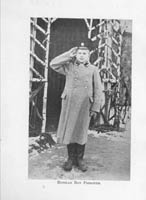 By the middle of 1916, American YMCA WPA operations assisted thousands of men in Germany. The issue facing the
leadership was the expansion of the scope of Association work for Allied prisoners, both in the number of secretaries
and the range of services rendered. The International Committee could not introduce new programs or expand the number
of secretaries in Germany without a reciprocal increase in WPA personnel and services in Allied countries. In addition,
much of this POW relief work was pioneering in nature, and problems constantly emerged. The YMCA strove to improve the
efficiency of their operations, especially in terms of organizational reform and infrastructure development.
By the middle of 1916, American YMCA WPA operations assisted thousands of men in Germany. The issue facing the
leadership was the expansion of the scope of Association work for Allied prisoners, both in the number of secretaries
and the range of services rendered. The International Committee could not introduce new programs or expand the number
of secretaries in Germany without a reciprocal increase in WPA personnel and services in Allied countries. In addition,
much of this POW relief work was pioneering in nature, and problems constantly emerged. The YMCA strove to improve the
efficiency of their operations, especially in terms of organizational reform and infrastructure development.
Notes:
Note 1: "Then shall the King say unto them on his right hand, Come, ye blessed of my Father, inherit the kingdom prepared for you from the foundation of the world; For I was an hungred, and ye gave me meat; I was thirsty, and ye gave me drink; I was a stranger, and ye took me in; Naked, and ye clothed me; I was sick, and ye visited me; I was in prison, and ye came unto me. Then shall the righteous answer him, saying, Lord, when saw we thee an hungred, and fed thee? or thirsty, and gave thee drink? When saw we thee a stranger, and took thee in? or naked, and clothed thee? Or when we saw thee sick, or in prison, and came unto thee? And the King shall answer and say unto them, Verily, I say unto you, Inasmuch as ye have done it unto one of the least of these my brethren, ye have done it unto me." The Gospel of Matthew, 25:34-40 (King James Version). The American YMCA adopted the theme of "In Prison, Ye Visited Me" as the biblical basis for their War Prisoners' Assistance program to provide aid to the POW's of all nations. Back.
Note 2: John R. Mott, "The Insistent Demand for Service among Soldiers of Warring Countries in Camps, Prisons, and Hospitals," Association Men 41 (June 1916): 485. back
Note 3: Conrad Hoffman, "In Prison, Ye Visited Me," For the Millions of Men Now Under Arms 1 (15 April 1916): 44-45; and Mott, "The Insistent Demand for Service," among Soldiers of Warring Countries in Camps, Prisons, and Hospitals," Association Men, 41 (June 1916), p. 485. back
Note 4: Examples of the implementation of the American Four-fold Association program abound in articles in Association Men and in reports in For the Millions of Men Now Under Arms. Conrad Hoffman also provides a detailed summary in his book of wartime experiences in Germany, In the Prison Camps of Germany: A Narrative of "Y" Service among Prisoners of War (New York: Association Press, 1920), 84-85. Association Men was the official monthly magazine of the American YMCA. The journal, For the Millions of Men Now Under Arms, was a limited subscription publication produced by the International Committee of the North American Young Men's Christian Associations during World War I and the immediate post-war years. The International Committee published the first issue on 1 March 1915 on a "Strictly Private, Not to Be Published" basis and the series ended with the 1921 edition (number 19), which focused on "The Young Men's Christian Association in Poland." The journal incorporated photographs for the first time in the third issue (24 June 1915). John R. Mott originally used the publication to promote the wartime activities of the American YMCA in war-torn Europe among the Association's financial supporters. In 1915, the United States was still a neutral nation and widespread knowledge of the YMCA's welfare operations in support of the belligerents could have had a dramatic impact on the country's foreign policy. Even after Congress declared war on Germany in April 1917, For the Millions of Men Now Under Arms remained a confidential source of Red Triangle information because American WPA secretaries continued to provide relief aid to Central Power POWs and Mott did not want to jeopardize the organization's sources of funding. After the war, issues of For the Millions of Men Now Under Arms appeared in libraries bound in three volumes (although the third volume often is listed under different titles reflecting the contents of the series' last six issues). back
Note 5: One example of this important service is illustrated by M. M. Bartholomew's organization of a prisoner information bureau in the Irkutsk district of Siberia. The bureau was so successful that the Russian authorities used it as a model in other districts across the Russian Empire. Marshall M. Bartholomew, "From Mr. Bartholomew," For the Millions of Men Now Under Arms 1 (15 July 1916): 23-25. back
Note 6: Examples of these special services fill hundreds of reports in the Kautz Family YMCA Archives at the University of Minnesota Libraries in Minneapolis. For example, Walter Lowrie, the American secretary assigned to POW relief in Italy, found eight Protestant Hungarian ministers in one prison camp. This facility had a total of thirteen Protestant prisoners. Lowrie succeeded in having the ministers transferred to other camps that had sizeable Protestant populations but had no ministers. Regarding religious articles, Hoffman reported on the problems associated with sending altar cloths through German customs to initiate Orthodox services for Russian prisoners in Germany. The YMCA made special arrangements to make sure that religious articles were not desecrated during the shipping and inspection process. In terms of special Christmas activities, the American YMCA made every effort to spread cheer among POWs during the Yuletide. A major service the Association provided to German and Austro-Hungarian prisoners interned in Japan was providing fresh Christmas trees. Walter Lowrie, "Dr. Lowrie's Visits Welcomed," For the Millions of Men Now Under Arms 1 (15 April 1916): 49-50; Hoffman, In the Prison Camps of Germany, 77-78; and Galen Fisher, "Christmas Trees for German Prisoners in Japan," For the Millions of Men Now Under Arms 1 (15 March 1915): 24. back
Note 7: University extension classes were established at Cambridge University for German and Austro-Hungarian POWs, at Mauthausen in Austria for Italian prisoners, and at Ruhleben in Germany for English internees. University professors taught the classes, and prisoners earned college credit. Hoffman, In the Prison Camps of Germany, 44-46; "Austria-Hungary: For Prisoners of War," For the Millions of Men Now Under Arms 2 (1 February 1917): 40-41; Mac H. Donaldson, "Work Among Illiterate Russian Prisoners," For the Millions of Men Now Under Arms 2 (1 February 1917): 42-43; Louis Philip Penningroth, ""Young Boys in the Prison Camps," For the Millions of Men Now Under Arms 2 (1 February 1917): 43. back
Note 8: F. F. Jordan, "Orenburg: What One Man Did in a Single Camp," For the Millions of Men Now Under Arms 2 (1 June 1917): 16-22; and "For Prisoners of War: Wieselburg - Camp of 57,000," For the Millions of Men Now Under Arms 1 (31 July 1916): 38-41. back
Note 9: The YMCA used the term "hut" to describe the buildings where the organization conducted relief operations during World War I. The size of a hut varied from a shelled out cellar on the Western Front to large prefabricated buildings that measured sixty feet by one hundred twenty feet that could be assembled where needed. In the United States, the Association building served as the foundation for Red Triangle programs and American secretaries took this concept into consideration when developing services for prisoners of war. Julius F. Hecker to Archibald C. Harte, 5 May 1917, Lausanne, Switzerland, 1. John R. Mott Papers, Box 38, Folder 701, Yale School of Divinity, New Haven, CT; and "Hungarian Officer, Prisoner in Siberia, and Russian Staff Officer, in Active Service, Who Wish to Give Their Lives to Association Work," For the Millions of Men Now Under Arms 2 (1 November 1917), 8D. back
Note 10: Archibald C. Harte, "From Our Secretary in Prison Camps in Germany, March 30, 1915," For the Millions of Men Now Under Arms 1 (24 June 1915): 10; Archibald C. Harte, "Report of the Work at Göttingen, Germany, March 30, 1915," For the Millions of Men Now Under Arms 1 (24 June 1915): 13; Archibald C. Harte, "The First War Prison Building for the Young Men's Christian Association, Göttingen, Germany," For the Millions of Men Now Under Arms 1 (24 June 1915): 17; and Executive of the World's Committee of YMCAs, "World's Committee of Young Men's Christian Associations, Plenary Meeting of 1920 at Geneva: Report of the Executive for the Period July 1914 to June 1920," The Sphere 2:3 (1921): 195. back
Note 11: Harte, "From Our Secretary in Prison Camps in Germany, March 30, 1915," 13; and Archibald C. Harte, "From Our Secretary in Germany, April 4, 1915," For the Millions of Men Now Under Arms 1 (24 June 1915): 14. back
Note 12: Harte, "Report of the Work at Göttingen, Germany," March 30, 1915," For the Millions of Men Now Under Arms, 1 (June 24, 1915), pp. 13-14; John R. Mott to Christian Phildius, 24 July 1915, New York, 1. World's Alliance Box X391.2: "War Prisoners' Aid YMCA, 1914-915; POW Camps in Germany and France; War Guilt Question." Section 43: "Germany." Folder: "War Prisoners' Aid in Germany: Miscellaneous." World's Alliance of YMCA Archives, Geneva, Switzerland; and Olin D. Wannamaker, For the Six Million Prisoners: The Welfare Work of the YMCA in the Prison Camps of Ten Nations during World War I (September 1921), 57. back
Note 13: The World's Committee of the World's Alliance fully expected to supervise Association relief work around the world. Mott wrote to Paul Des Gouttes and Emmanuel Sautter on 12 January 1915, indicating that the two American YMCA representatives, Harte and Hibbard, would initiate POW relief work under the direction of the World's Alliance. Hibbard wrote a memorandum to the World's Alliance in February 1915 that declared that Harte and Hibbard's task was to aid the World's Committee in special work for soldiers and war prisoners, a document that was approved by Mott on March 23. Two days later, Des Gouttes corresponded with Mott, requiring that all Red Triangle work must be conducted under World's Committee direction. Mott replied on April 14, agreeing that all War Work for belligerent soldiers should be supervised by the World's Alliance. As late as May 12, Mott wrote to Phildius acknowledging that all funding provided by the American YMCA could appear on the books of the World's Committee. Despite the deference the International Committee in New York showed the World's Committee in Geneva early in the war, the American perspective changed radically over time. The resources of the World's Alliance were severely curtailed when Britain declared war against Germany in August 1914 and the American YMCA became the only organization that could provide men and finances to support Red Triangle relief operations. By the very nature of the organization, which operated with a loose umbrella structure, the International Committee in New York could operate independently of the Geneva headquarters. Harte used this to his advantage while conducting negotiations with belligerent governments. "Memorandum to Mr. Henroid," circa June 1918, 2-3. World's Alliance Box X391: "War Work Y.M.C.A., 1914-1918: World's Committee, Geneva." Folder: "War Prisoners' Aid Y.M.C.A. - Lists of Secretaries/Instructions for Secretaries, 1914-1918." World's Alliance of YMCAs Archives, Geneva; and Wannamaker, Six Million, 55-56. back
Note 14: Christian Phildius to John R. Mott, 29 April 1915, Geneva, 1-6. World's Alliance Box X391.2: "War Prisoners' Aid YMCA, 1914-1915; POW Camps in Germany and France; War Guilt Question." Section 43: "Germany." Folder: "War Prisoners' Aid in Germany: Miscellaneous." World's Alliance of YMCA Archives, Geneva. back
Note 15: Archibald C. Harte, "From Our Secretary in Germany, April 4, 1915," For the Millions of Men Now Under Arms 1 (24 June 1915): 14; Archibald C. Harte, "The First War Prison Building for the Young Men's Christian Association, Göttingen, Germany," For the Millions of Men Now Under Arms 1 (24 June 1915), 18; and Wannamaker, Six Million, 56. back
Note 16: Harte, "From Our Secretary in Germany, April 4, 1915," For the Millions of Men Now Under Arms, 1 (June 24, 1915), pp. 14-15. back
Note 17: Archibald C. Harte, "Address of Our Secretary at the Opening of the Building in the Prison Camp at Göttingen," For the Millions of Men Now Under Arms 1 (15 September 1915): 13. back
Note 18: Ibid., 14. back
Note 19: James W. Gerard, "Embassy of the United States of America, Germany, Berlin, April 10, 1915," For the Millions of Men Now Under Arms 1 (24 June 1915): 15; William Jennings Bryan, "Telegram from the Secretary of State, Washington, D.C., April 21, 1915," For the Millions of Men Now Under Arms 1 (24 June 1915): 15-16; James W. Gerard, "Embassy of the United States of America, Berlin, Germany, April 29, 1915," For the Millions of Men Now Under Arms 1 (24 June 1915): 16; Archibald C. Harte, "The First War Prison Building for the Young Men's Christian Association, Göttingen, Germany," For the Millions of Men Now Under Arms 1 (24 June 1915): 17-18; Archibald C. Harte, "Address of Our Secretary at the Opening of the Building in the Prison Camp at Göttingen," For the Millions of Men Now Under Arms 1 (1 September 1 1915): 14-15; Christian Phildius to John R. Mott, April 29, 1915, Geneva, 1-2. World's Alliance Box X391.2: "War Prisoners' Aid YMCA, 1914-1915; POW Camps in Germany and France; War Guilt Question." Section 43: "Germany." Folder: "War Prisoners' Aid in Germany: Miscellaneous." World's Alliance of YMCA Archives, Geneva, Switzerland; D. Carl Stange, Das Gefangenenlager in Göttingen (Göttingen: Louis Hofer, n.d.), 1-54. World's Alliance Box X391.2: "War Prisoners' Aid YMCA, 1914-1915; POW Camps in Germany and France; War Guilt Question." Section 43: "Germany." Publications. World's Alliance of YMCA Archives, Geneva, Switzerland; 1914-1915: Camp de Göttingen: La Maison du Prisonnier de Guerre: Inauguration Officielle, 15 Avril 1915: Compte-Rendu (Göttingen: Louis Hofer, 1915), 1-20. "Camp des Prisonniers de Göttingen: Le 15 Avril 1915: Inauguration Officielle del la `Maison du Prisonnier de Guerre' Program," 15 April 1915, 1-20. Armed Services Records Box AS-49: "German Publications, Circa 1918 (Prisoner of War Work) and Armed Services Records Box AS-20. Box 673.6: "Reports, Clippings, Publications, 1915-1921: World War #1: Prisoners of War." Folder E: "Prisoners of War, YMCA Work for Germany." Kautz Family YMCA Archives, University of Minnesota, Minneapolis, MN; "War Prison Camps in Europe: Scenes of Y.M.C.A. Work," New York Daily News (30 October 1915), 5. Box X673.6: "Reports, Clippings, Publications, 1915-1921: World War #1: Prisoners of War." Folder E: "Prisoners of War, YMCA Work for Germany." Kautz Family YMCA Archives, University of Minnesota, Minneapolis, MN; William Howard Taft, Frederick Harris, Frederic Houston Kent, and William J. Newlin, eds., Service with Fighting Men: An Account of the Work of the American Young Men's Christian Association in the World War, 2 vols. (New York: Association Press, 1922), 2:300; Hoffman, In the Prison Camps of Germany, 17; and Executive of the World's Committee of YMCAs, "World's Committee of Young Men's Christian Associations, Plenary Meeting of 1920 at Geneva: Report of the Executive for the Period July 1914 to June 1920," The Sphere 2:3 (1921): 195. back
Note 20: James W. Gerard, "Embassy of the United States of America, Germany, Berlin, April 10, 1915," 15; William Jennings Bryan, "Telegram from the Secretary of State, Washington, D.C., April 21, 1915," 15-16; James W. Gerard, "Embassy of the United States of America, Berlin, Germany, April 29, 1915," 16; Archibald C. Harte, "The First War Prison Building for the Young Men's Christian Association, Göttingen, Germany," 17-18; Bogen, "The Opening of the Association Building at Göttingen: Speech by Colonel Bogen, the Commandant," For the Millions of Men Now Under Arms 1 (6 December 1915): 45-47; 1914-1915: Camp de Göttingen: La Maison du Prisonnier de Guerre, 1-15; and 1914-1915, Camp de Göttingen: La Maison du Prisonnier de Guerre: Inauguration Officielle, 15 Avril 1915, Compte-Rendu (Göttingen: Louis Hofer, 1915), 1-20. Armed Services Records Box AS-20. Box 673.6: "Reports, Clippings, Publications, 1915-1921: World War #1: Prisoners of War." Folder E: "Prisoners of War, YMCA Work for Germany." Kautz Family YMCA Archives, University of Minnesota Libraries, Minneapolis, MN. back
Note 21: James W. Gerard, "Embassy of the United States of America, Berlin, Germany, April 29, 1915," For the Millions of Men Now Under Arms 1 (24 June 1915), 16. back
Note 22: Gerard believed the appearance of the Spanish ambassador at the Göttingen inauguration ceremony was very important from a diplomatic perspective. The Spanish represented the interests of France and other Allied powers in Germany. While the Spanish ambassador was unable to attend the function, the Spanish consul did participate. James W. Gerard, "Embassy of the United States of America, Germany, Berlin, April 10, 1915," 15; William Jennings Bryan, "Telegram from the Secretary of State, Washington, D.C., April 21, 1915," 16; James W. Gerard, "Embassy of the United States of America, Berlin, Germany, April 29, 1915," 16; and Adolf Deissmann, "Protestant Weekly Letter, by Prof. Dr. Adolf Deissmann, Berlin University, 17," 26 March 1915, Berlin, 1-6. Armed Services Records Box AS-20. Box X673.6: "Reports, Clippings, Publications, 1915-1921: World War #1: Prisoners of War." Folder E: "Prisoners of War, YMCA Work for Germany." Kautz Family YMCA Archives, University of Minnesota Libraries, Minneapolis, MN. back
Note 23: James W. Gerard, "Germany: Cable from Ambassador Gerard through the State Department, Washington, August 2, 1915, to John R. Mott," For the Millions of Men Now Under Arms 1 (15 September 1915): 13. back
Note 24: Taft, Harris, Kent, and Newlin, Service with Fighting Men, 2:297; Henry C. Mahoney, Interned in Germany (London: Sampson Low, Marston, and Company, Ltd., 1918), 143-63; and Wannamaker, Six Million, 88-89. back
Note 25: Wannamaker, Six Million, 56 and 89. back
Note 26: This permit also instructed that Hoffman should work to get German prisoners out of dangerous climates in the French and British colonies. The Germans were convinced that POWs were suffering in tropical Africa and demanded their reassignment to healthier climes. Friedrich to Archibald C. Harte, Kriegsministerium #1520.9.15.05, 30 September 1915, Berlin, Germany, 1. General Report, circa March 1917, 1. World's Alliance Box X391.2: "War Prisoners' Aid YMCA, 1914-1915; POW Camps in Germany and France; War Guilt Question." Section 43: "Germany." Folder X391.2 (43): "War Prisoners' Aid in Germany, 1914-1918." World's Alliance of YMCAs Archives, Geneva; Kriegsministerium, Nr. 1406/11.14.U3, 15 February 1915, Berlin. World's Alliance Box X391.2: "War Prisoners' Aid YMCA, 1914-1915; POW Camps in Germany and France; War Guilt Question." Section 43: "Germany." World's Alliance of YMCA Archives, Geneva, Switzerland; Hoffman, In the Prison Camps of Germany, 30-33; Conrad Hoffman, "Prisoners of War in Germany: Letters from Conrad Hoffman," For the Millions of Men Now Under Arms 1 (31 January 1916), 36; and Taft, Harris, Kent, and Newlin, Service with Fighting Men, 2:294. back
Note 27: Hoffman, In the Prison Camps of Germany, 30-32; Archibald C. Harte, "With the Prisoners of War," in In the Camps, Trenches, and Prisons of Asia, Africa, and Europe (Oxford: Frederick Hall, 1916), 36; and E. O. Jacob, "Report of E. O. Jacob: For the Year Ending September 30, 1917," 30 September 1917, 13. Armed Services Records Box AS-20. Box 673.6: "Reports, Clippings, Publications, 1915-1921: World War #1: Prisoners of War." Folder E: "Prisoners of War, YMCA Work for Germany." Kautz Family YMCA Archives, University of Minnesota Libraries, Minneapolis, MN. back
Note 28: Hoffman, In the Prison Camps of Germany, 34-37; James E. Sprunger and Conrad Hoffman, "Bericht der Herren J. E. Sprunger und Conrad Hoffmann, Internationale Vertreter des Christlichen Vereins Jünger Männer," November 1915, 1-24. Armed Services Box X673.6: "Reports, Clippings, Publications, 1915-1921: World War #1: Prisoners of War." Folder E: "Prisoners of War, YMCA Work for Germany." Kautz Family YMCA Archives, University of Minnesota Libraries, Minneapolis, MN; Taft, Harris, Kent, and Newlin, Service with Fighting Men, 2:294; J. Scott Keltie and M. Epstein, eds., The Statesman's Year-Book: Statistical and Historical Annual of the States of the World for the Year 1915 (London: Macmillan and Company, 1915), 974 and 987; Geoffrey Hindley, The Royal Families of Europe (Secaucus, NJ: Chartwell Books, Inc., 1979), 34-35. back
Note 29: Hoffman, In the Prison Camps of Germany, 40. back
Note 30: Conrad Hoffman, "Prisoners of War in Germany: Letters from Conrad Hoffman," For the Millions of Men Now Under Arms 1 (31 January 1916): 36-38; Hoffman, In the Prison Camps of Germany, 37-41; and James E. Sprunger and Conrad Hoffman, "Bericht der Herren J. E. Sprunger und Conrad Hoffmann, Internationale Vertreter des Christlichen Vereins jünger Männer," 1-24. Armed Services Box X673.6: "Reports, Clippings, Publications, 1915-1921: World War #1: Prisoners of War." Folder E: "Prisoners of War, YMCA Work for Germany." YMCA's of the USA Archives, Minneapolis, MN. back
Note 31: Conrad Hoffman, "Prisoners of War in Germany: Letters from Conrad Hoffman," 39; and Israel Cohen, The Ruhleben Prison Camp: A Record of Nineteen Months' Internment (London: Methuen and Company, 1917), 150. back
Note 32: Marshall M. Bartholomew, "A Visit to Prison Camps," For the Millions of Men Now Under Arms 1 (6 December 1915), 44-45. back
Note 33: Herman C. Rutgers, "Report: March 18, 1916," For the Millions of Men Now Under Arms 1 (15 April 1916): 41-42. back
Note 34: Herman C. Rutgers, "Report: March 18, 1916," For the Millions of Men Now Under Arms 1 (15 April 1916), 41-42. back
Note 35: Conrad Hoffman, "Prisoners of War in Germany: Letters from Conrad Hoffman," 39. back
Note 36: "Association Building for Russian Prisoners, Crossen, Germany," For the Millions of Men Now Under Arms 1 (15 September 1915), 30D; "The Camp Centre and Watch Tower at Crossen, Germany," For the Millions of Men Now Under Arms 1 (24 June 1915): 36B; "Prison Camp at Crossen, Germany, Showing Church and Site of the Association Building Opposite," For the Millions of Men Now Under Arms 2 (1 February 1917): 26A; Executive of the World's Committee of YMCAs, "World's Committee of Young Men's Christian Associations, Plenary Meeting of 1920 at Geneva: Report of the Executive for the Period July 1914 to June 1920," The Sphere 2:3 (1921): 195; "Programm zur Einweihungsfeier der Lesehalle gestiftet von der Kriegsgefangenenlager Crossen a. Oder 29. Mai 1915," 29 May 1915, Crossen-an-der-Oder, Germany, 1-4. Armed Services Box X673.6: "Reports, Clippings, Publications, 1915-1921: World War #1: Prisoners of War." Folder E: "Prisoners of War, YMCA Work for Germany." Kautz Family YMCA Archives, Minneapolis, MN; and Wannamaker, Six Million, 109-10. back
Note 37: "Reading Room of the Association in the Prisoners-of-War Camp at Göttingen," For the Millions of Men Now Under Arms 1 (6 December 1915): 10B; James W. Gerard, "The Association in Prisoners of War Camps: Observations of Its Work Given by Hon. James W. Gerard, Ex-Ambassador to Germany before the West Side New York Association," Association Men 42 (May 1917): 438; Taft, Harris, Kent, and Newlin, Service with Fighting Men, 2:293-94; and Wannamaker, Six Million, 110. back
Note 38: Hoffman, In the Prison Camps of Germany, 42-49; A. D. McLaren, "Berlin and Ruhleben during the War," Contemporary Review 119 (February 1916): 221-22; Eric Farmer, "The Psychology of a Prison Camp," Quarterly Review 231 (April 1919): 396-408; Francis Gribble, "Leaves from a Ruhleben Notebook," Fortnightly Review 105 (January 1916): 60-70; Peter Michelson, "In Ruhleben Prison Camp," Century Magazine 94 (July 1917): 364-75; A. M. D. Hughes, "Ruhleben," Living Age 288 (12 February 1917): 410-17; Henry C. Mahoney, Interned in Germany (London: Sampson Low, Marston, and Company, 1918), 75-92 and 176-92; Hugh Cimino, Behind the Prison Bars in Germany: A Detailed Record of Six Months' Experiences in German Prison Camps and Detention Centers by a British Doctor Who Has Just Been Released (London: George Newnes, 1915), 111-17; Wallace Ellison, Escaped! Adventures in German Captivity (Edinburgh: William Blackwood and Sons, 1918), 38-45 and 56-73; and Taft, Harris, Kent, and Newlin, Service with Fighting Men, 2:297-98. back
Note 39: Hoffman, In the Prison Camps of Germany, 45-49 and 53-56; James W. Gerard, "The Association in Prisoners of War Camps," 438; "Arthur Eckley Lechmere and Science at Ruhleben," Nature 102 (27 February 1919): 504; Arthur Gradenwitz, "Science in German Concentration Camps: Necessary Not Only for Humanitarian Reasons, But for Self-Preservation," Scientific American 113 (3 July 1915): 10-11; "The Ruhleben Camp School," School and Society 4 (21 October 1916): 628-29; Francis Gribble, "The Medical History of Ruhleben," Edinburgh Review 229 (April 1919): 290-309; Lena Ashwell, "The Theatre at Ruhleben," Fortnightly Review 110 (October 1918): 574-79; "Music and Drama in the German Prison Camps," Literary Digest 54 (24 March 1917): 816-17; Cohen, Ruhleben Prison Camp, 150 and 153-54; Mahoney, Interned in Germany, 127-63; In the Hands of the Huns: Being the Reminiscences of a British Civil Prisoner of War 1914-1915: Illustrated with Unique Sketches Drawn by Prisoners in Ruhleben Camp, and Which Appeared in the "Camp News," 2nd ed. (London: Simpkin Marshall Hamilton Kent and Company, Ltd., 1916), 66-69; and J. Davidson Ketchum, Ruhleben: A Prison Camp Society (Toronto: University of Toronto Press, 1965), 112, 123, and 318-19. back
Note 40: Conrad Hoffman, "Gospel Meetings at Ruhleben," For the Millions of Men Now Under Arms 1 (15 April 1916), 38-39; Hoffman, In the Prison Camps of Germany, 49-50; H. Bl., "Im englischen Gefangenenlager in Ruhleben," Berliner Lokal-Auszeiger (25 December 25). Armed Services Records Box AS-20. Box X673.6: "Reports, Clippings, Publications, 1915-1921: World War #1: Prisoners of War." Folder E: "Prisoners of War, YMCA Work for Germany." Family YMCA Archives, University of Minnesota Libraries, MN Cohen, Ruhleben Prison Camp, 176; Mahoney, Interned in Germany, 40-48; Wannamaker, Six Million, 109; and Ketchum, Ruhleben: A Prison Camp Society, 156 and 316-17. back
Note 41: Conrad Hoffman, "Gospel Meetings at Ruhleben," For the Millions of Men Now Under Arms 1 (15 April 1916), 39-40; Hoffman, In the Prison Camps of Germany, 51-52; Herbert Bury, "Concerning Prisoners of War," The Nineteenth Century 79 (April 1916): 808; Cohen, Ruhleben Prison Camp, 194-95; and Ketchum, Ruhleben: A Prison Camp Society, 112, 170-71, and 319. back
Note 42: Conrad Hoffman, "Gospel Meetings at Ruhleben," For the Millions of Men Now Under Arms 1 (15 April 1916), 39-40; and Hoffman, In the Prison Camps of Germany, 54. back
Note 43: "Devotional Conference at Ruhleben," For the Millions of Men Now Under Arms 2 (1 February 1917), 45-46; Conrad Hoffman, "Good Will of Outside Friends Finds Expression," For the Millions of Men Now Under Arms 2 (1 June 1917), 46; and Ketchum, Ruhleben: A Prison Camp Society, 246-47 and 332-33. back
Note 44: Herbert Bury, "The Fight to Keep Up Courage," For the Millions of Men Now Under Arms 2 (1 February 1917), 45; Hoffman, In the Prison Camps of Germany, 56-58; Francis Gribble, "The Treatment of Prisoners in Germany," The Nineteenth Century 80 (July 1916): 73-78 and 84; Herbert Bury, "Concerning Prisoners of War," The Nineteenth Century 79 (April 1916): 805-7; Douglas Sladen, ed., In Ruhleben: Letters from a Prisoner to His Mother: With an Account of the "University" Life, Classes Sports, Food, Accommodation, Etc. of the Internment Camp of British Prisoners (London: Hurst and Blackett, Ltd., 1917), 26-36; Cimino, Behind the Prison Bars in Germany, 111-17; and Ketchum, Ruhleben: A Prison Camp Society, 246-47. back
Note 45: Conrad Hoffman, "Good Will of Outside Friends Finds Expression," For the Millions of Men Now Under Arms 2 (1 June 1917): 46; "Germany: For Prisoners of War," For the Millions of Men Now Under Arms 2 (1 February 1917): 44-45; "Gratitude Not Always a Lively Sense of Favors to Come," For the Millions of Men Now Under Arms 2 (1 November 1916): 42; Hoffman, In the Prison Camps of Germany, 54; E. O. Jacob, "Report of E. O. Jacob: For the Year Ending September 30, 1917," 30 September 1917, 3. Armed Services Records Box AS-20. Box 673.6: "Reports, Clippings, Publications, 1915-1921: World War #1: Prisoners of War." Folder E: "Prisoners of War, YMCA Work for Germany." Kautz Family YMCA Archives, University of Minnesota Libraries, MN; Mahoney, Interned in Germany, 243-60; In the Hands of the Huns, 78-81; A. D. McLaren, "Berlin and Ruhleben during the War," Fortnightly Review, 119 (February 1916), 221; and "Germany's Civilian Prisoners," Literary Digest 53 (26 August 1916): 448-49. back
Note 46: Conrad Hoffman, "Christmas Good Will in Prison Camps," For the Millions of Men Now Under Arms 1 (15 April 1916): 42-44; Hoffman, In the Prison Camps of Germany, 59-61; and Mahoney, Interned in Germany, 224-42. back
Note 47: General Report, circa March 1917, 1. World's Alliance Box X391.2: "War Prisoners' Aid YMCA, 1914-1915; POW Camps in Germany and France; War Guilt Question." Section 43: "Germany." Folder X391.2 (43): "War Prisoners' Aid in Germany, 1914-1918." World's Alliance of YMCAs Archives, Geneva; Conrad Hoffman, "Christmas Good Will in Prison Camps," 44; and Hoffman, In the Prison Camps of Germany, 62. back
Note 48:"Germany: Prisoners of War," For the Millions of Men Now Under Arms 1 (15 April 1916): 37-38; Daniel J. McCarthy, The Prisoner of War in Germany: The Care and Treatment of the Prison of War with a History of the Development of the Principle of Neutral Inspection and Control (New York: Moffat, Yard and Company, 1918), 44B; and Richard B. Speed III, Prisoners, Diplomats, and the Great War: A Study in the Diplomacy of Captivity (Westport: Greenwood Press, 1990), 64. back
Note 49: Conrad Hoffman, "A Senior Secretary's Report," For the Millions of Men Now Under Arms 1 (31 July 1916): 44; "Association Hall at Frankfurt-an-der-Oder Opened February 16th," For the Millions of Men Now Under Arms 1 (15 April 1916): 26D; and Feier zur Einweihung des Friedhofes im Kriegsgefangenenlager Frankfurt a/O. am 25. Juli 1915 (Berlin: Buchdruckerei Otto Lange, 1915), 1-4. "New York," No Date, i-k. Armed Services Records Box AS-20. Box 673.6: "Reports, Clippings, Publications, 1915-1921: World War #1: Prisoners of War." Folder E: "Prisoners of War, YMCA Work for Germany." Kautz Family YMCA Archives, University of Minnesota Libraries, Minneapolis, MN. back
Note 50: "A Prisoners' Monument (Designed by Prisoners and Erected with the Cooperation of the German Authorities to the Memory of the Prison Dead at the Camp of French Prisoners in Münster)," For the Millions of Men Now Under Arms 1 (6 December 1915): 10A; "French Soldiers in German Prison Camps," For the Millions of Men Now Under Arms 1 (31 January 1916): 26A; and McCarthy, The Prisoner of War in Germany, 160-61. back
Note 51: Conrad Hoffman, "A Senior Secretary's Report," 44; "Thrills of War—But the Tragedy of Peace," Literary Digest 59 (28 December 1918): 92; and "New York," No Date, h. Armed Services Records Box AS-20. Box X673.6: "Reports, Clippings, Publications, 1915-1921: World War #1: Prisoners of War." Folder E: "Prisoners of War, YMCA Work for Germany." Kautz Family YMCA Archives, University of Minnesota Libraries, Minneapolis, MN. back
Note 52: The $2,000 American YMCA contribution to the building fund at Ohrdruf represented about one-third of the projected costs. This sum represents the typical cost of hut construction during World War I and reflects the International Committee's policy of providing a financial basis for Association buildings overseas while requiring the recipients to invest in their organization as well, in this case, through canteen sales. James E. Sprunger, "Notes from Camps Visited by J. E. Sprunger," For the Millions of Men Now Under Arms 1 (15 April 1916): 45. back
Note 53: Thomas C. Hall, "Darmstadt Dedication: Address of Prof. Thomas C. Hall," For the Millions of Men Now Under Arms 2 (1 November 1916): 39-41. back
Note 54: James E. Sprunger, "Notes from Camps Visited by J. E. Sprunger," 45-46; For the Millions of Men Now Under Arms 1 (April 15, 1916), pp. 45-46; Thomas C. Hall, "Darmstadt Dedication: Address of Prof. Thomas C. Hall," 39-41; Carl Michel, "Study and Play at Darmstadt," For the Millions of Men Now Under Arms 2 (1 February 1917): 48; and "New York," No Date, i. Armed Services Records Box AS-20. Box X673.6: "Reports, Clippings, Publications, 1915-1921: World War #1: Prisoners of War." Folder E: "Prisoners of War, YMCA Work for Germany." Kautz Family YMCA Archives, University of Minnesota Libraries, Minneapolis, MN. back
Note 55: James E. Sprunger, "Notes from Camps Visited by J. E. Sprunger," 45-46; For the Millions of Men Now Under Arms, 1 (April 15, 1916), pp. 45-46; Thomas C. Hall, "Darmstadt Dedication: Address of Prof. Thomas C. Hall," 39-41; Carl Michel, "From the Letters of Some Secretaries," For the Millions of Men Now Under Arms 2 (1 November 1916): 42; Carl Michel, "Study and Play at Darmstadt," 48; and General Report, circa March 1917, 1. World's Alliance Box X391.2: "War Prisoners' Aid YMCA, 1914-1915; POW Camps in Germany and France; War Guilt Question." Section 43: "Germany." Folder X391.2 (43): "War Prisoners' Aid in Germany, 1914-1918." World's Alliance of YMCAs Archives, Geneva. back
Note 56: Kretzschmer, "General Kretzschmer's Speech at the Dedication of the Association Building in Kottbus, Germany," For the Millions of Men Now Under Arms 2 (1 February 1917): 47. back
Note 57: Ibid. back
Note 58: Ibid., 46-47; J. Gustav White, "Working Together at Kottbus," For the Millions of Men Now Under Arms 2 (1 June 1917): 48-49; and General Report, circa March 1917, 1. World's Alliance Box X391.2: "War Prisoners' Aid YMCA, 1914-1915; POW Camps in Germany and France; War Guilt Question." Section 43: "Germany." Folder X391.2 (43): "War Prisoners' Aid in Germany, 1914-1918." World's Alliance of YMCAs Archives, Geneva. back
